Building a future for all























Uncertainty is the feeling of our times. How do we deal with global challenges and their impact on life in our city? How do we plan? What is still to come? We don’t have an instruction manual for the world. But we do know how to keep Vienna running in practice, how to drive forward the climate revolution and how to invest for the future. We ensure quality of life in our city – no question.
How our measures will help achieve climate neutrality in Vienna by 2040.

How we are shaping the city of the future with our products and services.
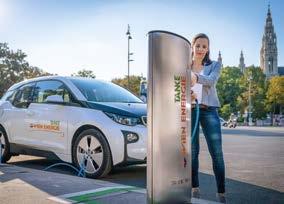
How we make targeted use of the expertise and dedication of our employees.
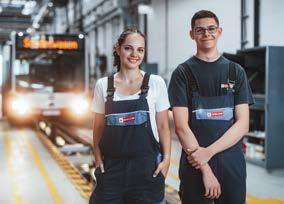

No leadership crew enjoys navigating a large ship through a heavy storm. The waves are high. The wind pushes unpredictably against the tiller. The crew has to give their all to ensure that the cargo remains secure. And yet: every storm also offers an opportunity for testing.
The past three years have taken your trusted ship, Wiener Stadtwerke, through several storms at once. And every time she has demonstrated that her construction is sturdy and her team well trained. She has succeeded in keeping her passengers’ luggage dry
and their cabins warm. On the Management Board, we are grateful for and proud of this.
The upheavals across the entire European energy market in the past year have shown just how important it is to maintain and secure this stability again and again. They hit our Energy Division with full force in the summer. Nobody would have thought that the purchase price for energy could rise by more than 1,000% within a short period of time. We responded swiftly and decisively in close collaboration with the City of Vienna and in the interest of our customers.

In 2022, we have shown even more so than in recent years what it means to be a reliable provider of energy and infrastructure We have fulfilled our delivery promises, maintained our level of service and continued to pursue ongoing projects without restrictions – all thanks to a secure commercial foundation.
Every euro that we earn is invested in a meaningful way in the needs of our city. In 2022, we invested EUR 1.3bn in the expansion of our company’s services and making the Vienna metropolitan region fit for the future. Of this amount, almost EUR 1bn went to sustainable projects. We were able to finance the majority of this investment using current funds. This also shows that we operate conservatively and are financially stable.
This was again supported by good earnings, to which all divisions of the company contributed with improved figures. The Group’s revenue for 2022 rose by 70% to EUR 7.3bn. This significant increase came from the sharp rise in energy prices. Directly related to this, the cost of materials and cost of purchased services doubled to more than EUR 5.1bn. Despite the high costs, EBITDA adjusted for special effects increased by 41% to EUR 833m and adjusted profit for the year rose by 73% to EUR 488m.

Martin Krajcsir, Chief Executive Officer
“In 2022, we have shown even more so than in recent years what it means to be a reliable provider of energy and infrastructure.”
Martin Krajcsir, Chief Executive OfficerPeter Weinelt, Deputy Chief Executive Officer

We continue to make good progress with our operational projects. Construction work on our major U2xU5 project is largely proceeding according to plan and we are also developing our mobility networks and our range of services in many other areas. Our customers are acknowledging and making use of our efforts through an accelerated return to public transport – in 2022, passenger numbers increased by 25%.
In the area of energy, we continue to work at full speed on the expansion of renewable resources. Sun, wind, green hydrogen, regenerative heat and even cooling – we are using all technological pathways available to us to phase out fossil-fuel resources as quickly and as expansively as possible. For instance, we intend to be supplying 20,000 households in the Aspern district with green geothermal heating by 2026. And by 2030, this figure could be as high as 125,000 across Vienna. These and numerous other projects will enable us to gradually reduce our dependence on gas, especially in the residential sector. In industrial contexts, the need for higher temperatures means that such a transition will only be possible to a limited extent for the time being.
We are driving forward digitalisation, getting innovative ideas off the ground and expanding our services. And to keep doing all this, we need even more bright minds in the future. At the same time, demographic change is also at the forefront of our minds. That is why we have further enhanced our employer brand in recent months and are increasing our visibility in the region. Those who come on board with us can not only expect a varied workplace and a diverse team, but they can also play their part in a great undertaking for society.
As you will have noticed from the title, our
“We are using all technological pathways available to us to phase out fossil-fuel resources as quickly and as expansively as possible.”
Peter Weinelt, Deputy Chief Executive Officer
annual report is geared around the theme of “Vienna – a how-to guide”. You may wonder why we have opted for this instruction manual wording. This year, we have decided to give you a more tangible insight into the areas in which we work and what we do. Our world has become so complex that we quickly lose sight of how the various aspects of our everyday lives are connected. Mobility revolution. Energy revolution. Employment market revolution. Nowadays, these phrases are often bandied around without much more thought being given to them. But we associate them with specific projects and undertakings, some of which we work on seven days a week – for you as residents of Vienna and in the interest of the future of the regions in and around our capital.
The tasks facing those at the head of our company are not becoming any less challenging. This is why our Group Management Board will be expanded to three members at the beginning of the coming year. Until then, we will continue to work with all of our partners and our 16,000 employees on creating a sustainable, liveable future for Vienna.
Vienna, April 2023
Martin Krajcsir, Chief Executive Officer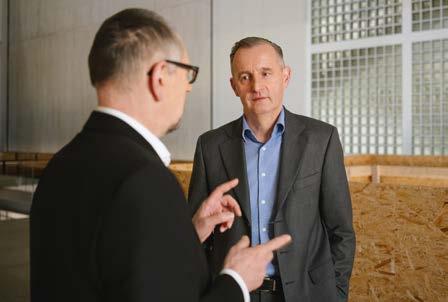 Peter Weinelt, Deputy Chief Executive Officer
Creating a sustainable, liveable future for Vienna, together
Peter Weinelt, Deputy Chief Executive Officer
Creating a sustainable, liveable future for Vienna, together
In the past year, Wiener Stadtwerke has been Vienna’s core climate protection partner and the key driver of the energy revolution within our city. No other company has such leverage or can map the entire value chain in so many areas when it comes to real improvements on the road to climate neutrality. In 2022, the Group significantly increased its sustainable investments compared to the previous year, with climate-related expenditure expected to exceed the billion-euro mark for the first time in 2023.
As the City of Vienna and Wiener Stadtwerke as a company, we are there for the people 100% of the time. Together, we take whatever path is necessary to maintain the highest possible quality of life at the most affordable price – even during periods of uncertainty, like we have been experiencing in the energy sector since the outbreak of war in Ukraine. The City of Vienna, the federal government, the European Union, the market participants themselves – they are all called upon to work together to stabilise the markets. After all, energy is the central resource on which we depend in everyday life and in business. We need to be able to rely on its supply.
We want to further strengthen the trust of the people who rely on us in these globally turbulent times, which is why the City of Vienna will not distribute a dividend from Wiener Stadtwerke to the municipal budget for the financial years 2022 and 2023. This means that all proceeds remain within the Group and can be used by Wiener Stadtwerke and its subsidiaries for the modernization and further expansion of the energy and transport systems.
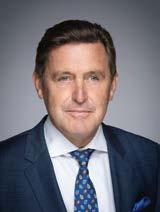
At the same time – and this is particularly important to us as a city that provides public services – the results generated are not transferred to the budget of the owner, the City of Vienna, but are intended to relieve the financial burden on the people of Vienna, who have been hit hard by high inflation, as much as possible.
Despite severe disruptions on the energy markets due to the war, Wien Energie was economically successful last year. This is a good and important thing and shows that Wien Energie is on a stable course even in difficult times. In particular, the stabilising market environment in the fourth quarter was beneficial when it came to successful trading in the power plants’ electricity production and in storage transactions. It is important to me to pass on this good result to our customers. I have therefore commissioned Wien Energie to put together an energy assistance package worth EUR 140m in total, which includes relief packages for all Wien Energie customers for electricity, gas and district heating and additional support for social hardship cases.
However, the most sustainable solution to the energy crisis remains moving away from gas. With a total investment of EUR 417m, Wien Energie is therefore putting more money into the expansion of renewable energies and new technologies than ever before. All this is proof of our promise: “We are here for you!”
“We are there when the citizens of Vienna need us.”
Peter Hanke, City Councillor for Finance, Economy, Labour, International Affairs and Wiener Stadtwerke
In 2022, it became clear just how important functioning governance is. Regulated interaction between the management and governance bodies ensures that a company stays on its strategic course. At Wiener Stadtwerke, the course is geared towards three main goals: achieving climate neutrality by 2040, developing a smart city that sets the standard at an international level, and sustainably maintaining and expanding a high quality of service for Vienna’s citizens. Wiener Stadtwerke once again made excellent progress towards all three goals in 2022.
In order to maintain this course, the Supervisory Board meets regularly throughout the year and discusses – to a large extent with the Management Board – the main developments within the Group. During these meetings, the decisions and measures taken by the Management Board are presented and the economic environment is explained.
Outside the meetings, too, there is regular and close dialogue with the management. This is important when, for instance, extraordinary events occur, such as last summer when the upheavals on the energy markets made it necessary to financially hedge risks
that increased at very short notice. In such situations, the citizens of Vienna should be able to rely on our decisions being made in a coordinated manner, proportionally and, above all, in the interest of the people.
I have chaired the Supervisory Board since last summer and am pleased that, with this highly competent group of people, we are able to see Wiener Stadtwerke through this dynamic phase of development.
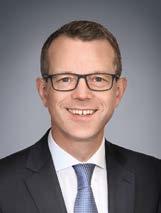
At the end of the year, our Chief Executive Officer Martin Krajcsir will hand over his responsibilities after 20 years of very successful management within the company. Martin has played a major role in developing Wiener Stadtwerke into a modern infrastructure and services company that is well-positioned for the future. On behalf of the Supervisory Board and the entire municipal authority, I would like to thank him for all he has done.
I would also like to thank the Management Board and the heads of the various divisions within the Group for once more reliably and proactively leading Wiener Stadtwerke over the past year. I would like to wish you all every success in the current year, and I look forward to continuing to cooperate with you in the spirit of meaningful and effective corporate governance.
“Markets today require a well-functioning interplay of leadership and control.”
Dietmar Griebler, Municipal Director and Chairman of the Supervisory Board of Wiener Stadtwerke


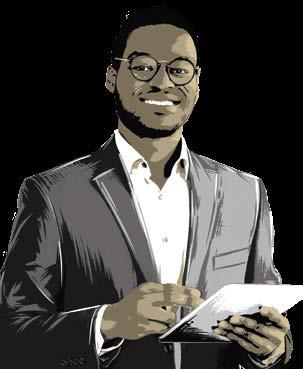


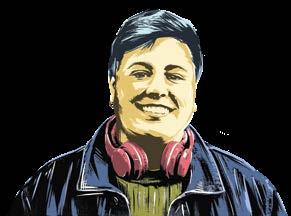
We are tasked with providing essential services to some two million people, whether it’s energy, megabits or mobility services. Our Group companies carry out this task together. As a team. It is both a challenge and a shared passion. And above all: it is a feat of strength from one day to the next.
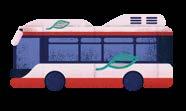

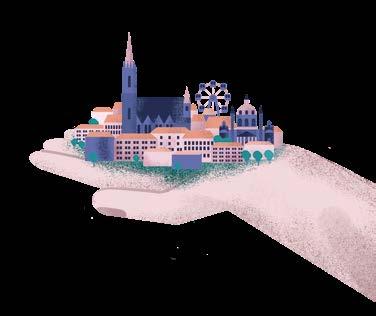
Wiener Stadtwerke bears a great responsibility, because it is all about the essentials. Our mission is to provide goods and services that are indispensable for our existence as human beings. Our task is simple: to enable everyone who lives in our city to access the essentials they need to get by – that means all citizens, all small and large businesses, industrial companies, organisations, and public institutions. 24 hours a day, 7 days a week, 365 days a year. With the help of our 16,000 employees, we ensure that the heating stays on and the water is kept warm, that the electricity comes out of the socket uninterrupted, that the public transport system gets passengers from A to B quickly, on time and safely, and that those in cars can find a parking space. In a nutshell: that everything that makes the heart of a city beat works seamlessly.
This provision of public services is a special duty. It has considerable social significance. There are no two ways about it: security and reliability are paramount. But our responsibility does not stop there. The demands and expectations placed on us are higher. And rightly so. Our services don’t just need to be secure – they also need to be fit for the future. And this is only possible if they help to progress the climate revolution in our city one step further every day. We bear a responsibility for ensuring a noticeable reduction in Vienna’s ecological footprint. For this reason, we ensure that we provide energy in a reliable way, while also making sure that it will soon come entirely from renewable sources. Likewise, we keep buses and rail services running reliably – and equip them with climate-friendly propulsion technologies. Wiener Stadtwerke is not just a modern infrastructure service provider, but also plays the largest role in terms of climate protection in Vienna and the surrounding area. Without us, Vienna cannot reach climate neutrality by 2040. The tasks we face in this regard are complex. But we will find the right solutions.

After 20 years in management positions and on the Management Board at Wiener Stadtwerke – including ten years as Chief Executive Officer – Martin Krajcsir will step down at the end of the year. Here, we take the opportunity for a brief (interim) report from him.
Mr Krajcsir: In December you will step down from the bridge. How are you doing with it?
Martin Krajcsir Well! This is a decision that has been in the planning for a long time, and is an opportunity both for me and for Wiener Stadtwerke. As the saying goes: we see things not as they are, but as we are. I am looking forward to seeing new places and, therefore, new perspectives. And it is good for Wiener Stadtwerke to receive fresh ideas from the bridge after such a long time.
But, of course, it will be emotional to leave. If you include my time with Wiener Linien, I have now been with this company for four decades. I have forged a
large number of relationships in this time, and I am very grateful for the shared experiences and for the trust that people have placed in me over the years.
How has Wiener Stadtwerke changed during your time with the company?
M. K. On the surface, we were, are and will always be a utility company. But on closer inspection Wiener Stadtwerke is now a completely different organisation. The spinoff from the municipal administration at the turn of the millennium was followed by liberalisation, restructuring, realignment and significant growth. Today, we are a modern, innovative company that operates efficiently and is 100% focused on its customers.
“A complex environment requires clear decisions by the leadership.”
Martin Krajcsir, Chief Executive Officer
Wiener Stadtwerke continues to be reliable, but is also modern and agile.
...a Group that is well prepared for the future?
M. K. I’m sure of it. The City of Vienna places a lot of trust in us to make its goals a reality. We have great respect for the duties that we are tasked with, but we also have lots of good ideas – and 16,000 pairs of hands that turn ideas into plans that we bring into everyday life with determination. I am sure that when we talk again in ten years’ time, the Group will have once again made significant strides. Ongoing digitalisation endeavours exponentially expand our possibilities, with corresponding opportunities for processes and services that bring added value to our customers.
What does the leadership of such a broadly positioned group need nowadays?
M. K. Objectivity, prudent action and the willingness to constantly place its point of view under scrutiny. Our world is becoming faster, more complex and more changeable. The task of leadership is to make clear decisions in this climate of imponderables and create a climate in which managers and employees can perform well. Team spirit is also material to success. This goes for the management team too. Open discussion on an equal footing, mutual appreciation and trust are very important. This was always the case with my colleague Peter Weinelt, and for that I am extremely grateful!
From 2024, the leadership team will grow from a duo to a trio...
M. K. Yes – this is an excellent decision on the part of the municipal authorities. Wiener Stadtwerke is one of the largest companies in Austria and is a driving force for Vienna as a business location. At the same time, however, we have major tasks ahead of us in our two major business areas of energy
and mobility. The labour market is also very challenging at the moment. From my point of view, a three-member management team is the right way to go.
M. K. I am curious about that myself! At the moment, I am so deeply involved in many subjects that I haven’t had time to think about these things at all. But I will still be a citizen of Vienna and Wiener Stadtwerke will remain a part of my home – it’s just that my perspective will change. I’m already looking forward to going to the Service Point, saying “Hello” and being asked: “Hello Mr Krajcsir, what can we do for you?”.
Martin Krajcsir, Chief Executive Officer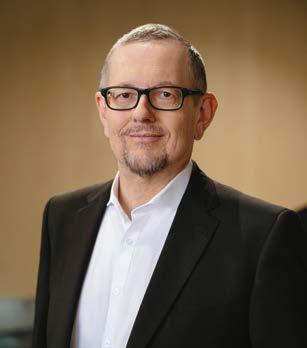
Several companies, several tasks, one common goal
Electricity, heating and cooling, mobility, internet and IT, housing, funeral services and cemeteries: every day, we ensure that the citizens of Vienna are well provided for across these diverse areas. People are at the heart of everything we do. Because they are not only our customers, but also our owners. We are owned in our entirety by the City of Vienna. And that also means that our company has millions of owners – the citizens of our city. In our dealings with them, we feel particularly committed to the values of integrity, reliability, transparency and a sense of responsibility.
We face up to our duties as a strong, united group. Our Group is made up of around 50 large and small companies that share a common goal: to be the high-performing, one-stop provider of Vienna’s infrastructure services. This is why we are strengthening collaborations, using synergies within the Group and optimising our processes and efficiency accordingly. The companies within our Group carry out their tasks shoulder-to-shoulder with expertise and passion. For them, it simply goes without saying.
We are the City of Vienna’s essential partner in making urban strategies and programmes a reality. Most importantly, we are making a tangible, measurable and indispensable contribution to the successful implementation of the city’s Smart Climate City strategy. By leveraging our core competencies, our business areas and our services, we are playing a significant role in two fundamental areas of the Smart Climate City strategy in
particular: in delivering a demand-oriented, secure, affordable, environmentally compatible energy supply and in providing climate-friendly mobility. Wiener Stadtwerke is the initiator and the designer in these areas. We know how to further enhance the high quality of life in our city, and how to do so in a very practical way. There is no question about it: our company has major, effective tools at its disposal for achieving ambitious goals and making Vienna climate neutral by 2040.
We can only meet the demands placed on Wiener Stadtwerke – and achieve the goals we set ourselves – if we secure our Group’s solid financial foundation in the long term. Stable finances are the prerequisite for any investment, be it in security of supply, sustainable mobility, climate protection, innovations or attractive jobs. We want to help shape Vienna’s path towards becoming a sustainable metropolitan region, and we believe that this requires a financial roadmap that is itself sustainable. Responsible business activity is one of our core corporate values.
Effective tools, ambitious goals: Wiener Stadtwerke is there for the people of Vienna 24/7.
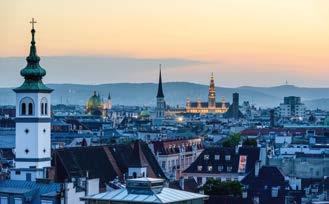

Wiener Stadtwerke is a publicly owned company. Therefore, we see transparency as an absolute necessity. We ensure that our owner, our supervisory bodies and the public have insight into our economic activities through clearly defined and comprehensible processes and structures. An internal control system ensures early detection of potential sources for risks and failures in business processes that could have negative economic, environmental and societal consequences. Regular audits ensure that the principles of profitability, purpose, security and correctness are observed in all work processes.
We also regularly evaluate and develop our Group-wide Compliance Management System (CMS), and its effectiveness is subject to independent audits at defined intervals. The Management Board and Supervisory Board receive written compliance reports, as well as verbal reports on a case-by-case basis as required. A Group-wide whistleblowing system has been set up and is used by employees, customers and suppliers.
The projects of Martin Maucha and Thomas Schmidt are exemplary of the fact that intra-Group collaboration not only works but is worthwhile. Martin works in the property management/housing department of Gemeinnützige Wohnungs- und Siedungsgesellschaft (GWSG), a subsidiary of Wiener Stadtwerke. A number of years ago he met Thomas Schmidt, an authorised representative of Wien Energie, in whom he found an ally for promoting the phasing out of oil and gas in residential construction too. They worked together to transform the heating system of GWSG’s largest housing complex on Lorystraße, which was then also fitted with a photovoltaic system in 2019.
The pair’s next project is to replace the gas central heating with a district heating connection. This will ensure that 300 flats can be heated in a more environmentally friendly way in the future. Martin and Thomas believe that “together we are taking an important step towards ending the dependence on fossil fuels in residential construction.” Their project was among the top ten in the Wiener Stadtwerke Climate Pioneers Contest, so they are not getting complacent. Wien Energie is currently examining the phasing out of gas in all GWSG residential complexes and is preparing for this in a pilot project in Neugebäudestraße, with a geothermal heat pump as the basis for the heating.
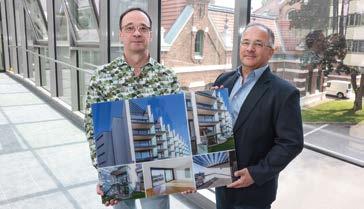
Wiener Stadtwerke is the largest municipal infrastructure service provider in Austria. Our Group unites companies that work together to ensure that life in our metropolis is able to carry on, securely and sustainably. This doesn’t only benefit the residents of Vienna, but also the commuters and customers in the surrounding area. Even corporations, small and medium-sized enterprises and governmental organisations based in Vienna benefit from Wiener Stadtwerke’s services, as do the many visitors to the city.
As the largest regional energy supplier in Austria, Wien Energie supplies two million people and some 230,000 commercial buildings and industrial plants in and around Vienna with electricity, heating, district cooling, and innovative energy services. Security of supply and climate protection are among our top priorities. The company also operates in the fields of telecommunications and electromobility. The distribution of electricity and gas is managed by the subsidiary Wien Energie Vertrieb.
Wiener Netze plans, expands and operates the energy grid. The company is Austria’s largest combined system operator of electricity, gas, district heating and data. The transition from the classic metering system to smart metering is also one of its tasks. Investments of more than EUR 300m per year go into maintaining, modernising and expanding the energy grids. This allows customers in Vienna and parts of Lower Austria and Burgenland to benefit from 99.99% security of supply. In the event that the electricity, gas or district heating systems do experience disruption, round-the-clock teams are deployed immediately.
With some 83 kilometres of underground tracks, 227 kilometres of tram tracks and 880 kilometres of bus routes, Wiener Linien manages the largest regional public transport network in Austria. At peak hours, the company transports up to 270,000 people in around 1,000 vehicles throughout the city at the same time. Wiener Linien ensures that around 2 million passengers arrive at their destinations quickly, easily and in an environmentally friendly manner every day.
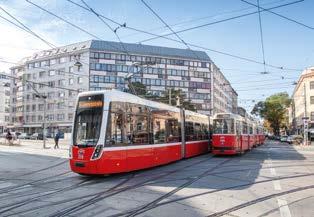 Wiener Linien takes 2 million passengers to their destinations every day in an environmentally friendly way.
Wiener Linien takes 2 million passengers to their destinations every day in an environmentally friendly way.
per year go into maintaining, modernising and expanding Vienna’s energy grids.
In addition to Wiener Linien, Wiener Lokalbahnen is another large transport company that forms part of the Wiener Stadtwerke Group. The company operates the Badner Bahn in the Greater Vienna Area, as well as several bus routes in and around the city. Wiener Lokalbahnen Verkehrsdienste (WLV) enables people with restricted mobility to reach their destinations in wheelchair-friendly minibuses. The subsidiary Wiener Lokalbahnen Cargo (WLC) handles rail cargo transport across Europe.
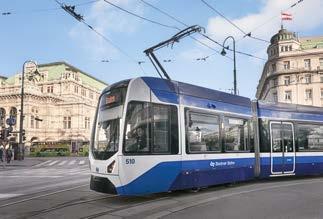
Wipark, one of Austria’s leading car park operators, is responsible for operating and managing multi-storey and open-air car parks and for planning and executing the construction projects associated with these. In doing so, Wipark partners with shopping, banking and business centres, cinemas, universities and A-plus locations in Vienna’s city centre. In addition to A-plus locations, the portfolio also includes park-and-ride car parks and collective residential car parks. The Group company operates nearly 80 car parks, with a total of 24,000 parking spaces.
Upstream Mobility ensures mobility with added value. The company operates a municipal digital platform that brings together all mobility service providers as well as other services, such as charging stations and multi-storey car parks. Public transport forms the backbone, with bike-sharing services, on-demand solutions and other innovative mobility services complementing the offering. Upstream Mobility also provides the digital infrastructure for a transport system of the future to interested municipalities and to private providers around the world. What’s more, the company analyses movement and mobility data for the public sector, which can be used to answer specific questions in the public interest.
The subsidiary WienIT is the Wiener Stadtwerke Group’s central IT and business partner. It provides our company with state-of-the-art IT and ensures that background processes run smoothly, from IT services, technical HR processes and printing jobs through to media planning. WienIT operates two computer centres, manages some 500 projects annually and supports around 10,000 functions directly and indirectly. With Digi.Lab, WienIT has its own research and development unit that is working today on the ideas of tomorrow, such as augmented and virtual reality.
80 car parks with 24,000 parking spaces are operated by the car park provider Wipark.
ImmOH!, formerly Facilitycomfort and Hauscomfort, is the real estate expert within the Stadtwerke Group. The companies provide technical and infrastructural services for residential buildings within the Wiener Stadtwerke Group and on behalf of customers in the third-party market, with tasks ranging from general maintenance through to incident management. It also offers numerous security-related services, as well as planning and construction services. A special feature of the corporate portfolio is greened façades. Buildings that are no longer needed to fulfil their core purpose are redeveloped into private residential space.
Friedhöfe Wien maintains more than 550,000 graves across 46 cemeteries with great care and experience. The company provides solace to grieving families and friends, and creates spaces to remember loved ones and come together. To make this possible at any time regardless of location, Friedhöfe Wien has created a novel fixed component for every grave plot – the digital grave. This makes it possible to visit a grave directly from home – to light a candle, manage dates and time periods or to meet in online memorial rooms. Friedhöfe Wien employees maintain a total of more than 5 km² of cemetery space. These natural oases make a valuable contribution to the quality of the air and life in Vienna, are used as local spaces for relaxation, and are protected habitats for numerous animals and plants. Friedhöfe Wien is also responsible for maintaining roads, paths and green spaces, as well as historic buildings and cultural monuments.
Bestattung Wien is Austria’s largest funeral home – and one of the largest in Europe. The company is a trusted partner for funeral services, carrying out approximately 10,000 funerals each year. Since its founding, more than two million burials and repatriations all around the world have been carried out. It
For an example of making cleaning more environmentally friendly, look no further than climate pioneer Dominik Dabrowski from Hauscomfort. On his initiative, a mobile osmosis system is used by the building cleaners to demineralise mop water. A brush that can be extended up to 20 metres via a carbon telescopic pole glides over windows, glass façades and photovoltaic systems and leaves a streak-free shine – without using any cleaning chemicals. Each year, this saves hundreds of litres of cleaning agent. Another advantage is that the system can be operated by a single person and without cherry pickers or lifting platforms, both of which consume energy. Dominik’s solution ranked among the top ten in the Wiener Stadtwerke Climate Pioneers Contest. From a personal perspective, it is important for him that we save resources: “I focus on saving energy, get electricity from hydropower, drive an electric car and buy locally.”
provides the bereaved with the most personal and uncomplicated support possible. Dismantling taboos surrounding death through education, campaigns and general PR work are also a key objective for the company. The focus at Friedhöfe Wien and Bestattung Wien is always on reliability, integrity and price transparency.
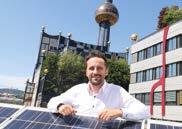
Providing secure, reliable and affordable services to our customers is our top priority. We know our duty. And we know that solutions that are fit for the future are essential, so we are always investing in these, especially when it comes to innovation and digitalisation. We want to make our products and services even more customer-friendly, efficient and environmentally friendly. An even more liveable Vienna – that’s what we work towards every day.
Our Group-wide trend scouting team continuously observes and evaluates new technologies, trends and market developments and uses the insights gained as inspiration for ideas and innovations. We then transform these into concrete innovative and digitalised solutions to make Vienna fit for the future. In 2022, the companies of the
Wiener Stadtwerke Group launched and carried out more than 100 research and innovation projects. Some of many areas in which we work and conduct research include augmented reality, blockchain, 3D printing, the Internet of Things, robotics, drones and data analytics.
The possibilities of our research activities are demonstrated by an AI-powered robot that has been conducting monitoring rounds at Austria’s largest power plant in Simmering since May 2022. This robot dog even interacts with humans by reporting incidents autonomously. Equipped with numerous specialised cameras and sensors, the Energy Dog – christened “ED” by the team – helps to secure the supply for more than 800,000 households in Vienna. The first robot dog of
Environmental monitoring and inspections aided by powerful drones – that is the specialist area of Patrick Enzinger, Michael Elias and Dominik Leeb. As part of Wien Energie’s first Innovation Challenge in 2017, the team developed concepts for how to optimise inspection reports for wind turbines, district heating pipelines, industrial chimney stacks and photovoltaic systems. Their employer, Wien Energie, was completely won over by the idea of using drones for a range of activities. Wien Energie founded the start-up Smart Inspection, which has since developed into a Wiener Stadtwerke Group competence centre. Its portfolio goes far beyond pure inspection activities – environmental monitoring has become one of the main areas of focus. Airborne multi-spectral cameras detect how well plants on green façades and roofs are doing or where native plants are being displaced by non-native species, or neophytes. Image recognition, laser scans and thermal imaging cameras are used to count wildlife or detect heat islands in the city. In addition to a varied fleet of drones, Smart Inspection now also has a mini-helicopter that can stay in the air for two hours while carrying up to seven kilograms. Smart Inspection flew into the top ten of the Wiener Stadtwerke Climate Pioneers Contest.
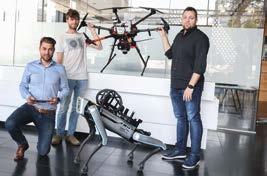
its kind in Europe, it has a thermal imaging camera to allow it to detect temperatures, as well as acoustic and olfactory sensors. It learns from his human colleagues and secures valuable knowledge that will no longer be lost as a result of the upcoming wave of retirements at Wien Energie. In the future, new technologies such as the Energy Dog will enable employees to be relieved of routine tasks and to concentrate on more complex tasks – a significant benefit in view of the potential shortage of skilled workers. The robot was developed by the US technology company Boston Dynamics and implemented by the start-up Smart Inspection, a partner company of Wiener Stadtwerke.
There is no question that innovative and digital solutions also contribute to climate protection when it comes to urban transport. A good example is WienBox, which Wiener Stadtwerke launched in response to the inundation of parcels resulting from online retailing. The project, started by Wiener Lokalbahnen, is bringing the collection and drop-off boxes of various providers together on a single platform for the first time. Currently, wienbox.at has almost 12,000 boxes across around 400 locations. This gives the citizens of Vienna an overview of the accessibility and features of the boxes in their vicinity, which they can use to pick up online orders or send returns. Compared to home delivery, the collection box system can lead to reductions of up to 40% in delivery-related CO2 emissions. With WienBox, we are making a smart contribution.

3D printers are considered to be one of the most significant technological revolutions of our era. They are used to create physical objects from digital files. They are also used at Wiener Netze. As the climate pioneers Stefan Arthaber, Thomas Dirr and Michele Möller describe it, the waste produced in the company will not be disposed of in future, but will be reused. By shredding, drying and further processing the waste and remnants of prototypes, it is possible to make new filament, which is plastic string that can be used again for new 3D prints – as circular an economy as you could hope for. The corresponding machines were procured and entered into operation in summer 2022.
Wiener Stadtwerke is a huge company, and our diverse services are used millions of times every year. We want to make things as easy as possible for our customers, and we are working to ensure that they find it just as convenient, straightforward and clear to contact us using digital means. In Vienna, services for energy supply, public transport, funerals and much more come from a single source – and since 2021 there has also been a standardised online access process for these thanks to logwien. Whether buying a ticket, submitting an electricity meter reading, booking a service or seeking advice – it has it all. This just makes life easier for customers, which is a key aspect of our Group’s digitalisation drive.
In a difficult environment, our sustainably oriented business policy has proven itself once again. We can look back on a successful business year in 2022, in which our earnings improved substantially both in the Group and in the business divisions. Substantial here means even without the extreme price effects that drove revenue to a historic record level. We have passed on the profits we have made to the people of Vienna on a 1:1 basis at many levels, and have improved our services. We have modernised and expanded the energy and mobility infrastructure. And we have invested heavily in sustainability.
The general conditions in 2022 were anything but favourable. The massive upheavals on the international energy markets as a result of the war in Ukraine brought the entire European energy supply industry to its limits at times. Energy prices rose to exorbitant levels at times during the summer, forcing the City of Vienna and the federal government to provide our Group with collateral at short notice. This experience once again confirmed our decision to implement our goal of moving away from gas as quickly and as far as possible. (See interview on page 28.)
Our Group revenue rose by 70% to EUR 7.3bn in the last year. This unusually high increase is due to the development in the Energy business division, where the increase is due to an interplay of four factors: sharp increases in energy prices, high cost of materials for gas, price hedging transactions for the high-efficiency combined heat and power (CHP) plant segment, and market price increases in the heating and cooling sales segment. The Energy division’s share of revenue once again increased significantly to EUR 5.9bn. It is currently around 81%. The division increased its revenue by 95% compared with the previous year.
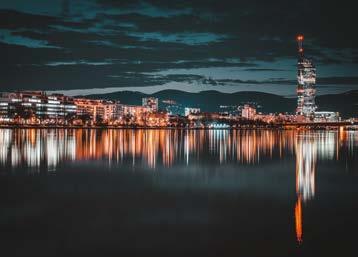 We modernised and expanded the energy and mobility infrastructure in 2022.
We modernised and expanded the energy and mobility infrastructure in 2022.
EUR 7.1bn
is being invested in climate-friendly projects by the Wiener Stadtwerke Group between 2023 and 2027.
The other divisions also showed positive development, but with more normal growth rates. Revenue in the Energy Grids division improved by 6% thanks to increased regulatory recognition of costs. The Transport division continued the positive trend that resumed in 2021 and increased its revenue by 13% in 2022. Revenue in the Funeral Services and Cemeteries and Car Parks divisions rose by 2% and 21% respectively. The double-digit increase in Car Parks is mainly down to changes in parking conditions – first and foremost the introduction of short-term parking zones in Vienna.
With the increased costs, especially in the area of energy, the cost of materials and purchased services doubled in the Group to EUR 5.1bn. The other expense items were either on par with the previous year or performed within the expected ranges, leading earnings to improve on the previous year overall. The operating result (EBIT) rose by 73% to EUR 489m, which is once again a very satisfactory figure. The main reason
for the improvement was energy-related income. The profit for the year, adjusted for special effects, rose by 73% to EUR 488m.
In order to ensure a sustainable economic balance and to pursue the operational projects cost-effectively, we had to pass on a large part of the increased costs to our clients last year.
The equity of our Group, which is wholly owned by the City of Vienna, rose 2% to EUR 7.8bn. The improvement is mainly due to the improved net income, while valuation effects in other comprehensive income put a dampener on the positive effect of the net income to a certain extent. The equity ratio improved by 6.4 percentage points to 43.9%.
Non-current liabilities fell 23% to EUR 5.9bn. Current liabilities were down 21% at EUR 4.0bn. Total assets fell by around 13% in 2022 to EUR 17.7bn, mainly due to changes in financial assets.
The company’s equity
rose by 2% to EUR 7.8bn.
Despite increased uncertainty on the financial markets, we intensified our investment course in 2022. Last year, we invested almost EUR 1.3bn in strengthening our sustainable performance. This is 28% more than the record value from the previous year. As in the previous year, 86% of the funds used were invested in property, plant and equipment and 14% in financial assets. Climate-friendly investments increased by more than onethird and almost reached the billion-euro mark (EUR 983m). The key areas of investment in 2022 were the expansion of the underground railway, grid expansion, further digitisation and, of course, the expansion of renewable energies. Investments in renewable energies amounted to more than EUR 200m and were used for the expansion of photovoltaics, wind power, large-scale heat pumps and geothermal energy.
We were able to satisfy the majority of the required investments with the operating cash flow, which is a great advantage for us in the current rising interest rate environment. We continued to receive considerable government investment grants for the Transport division.
As we have done for so many years, we will keep Vienna running safely in 2023 and beyond. In order to further strengthen security of supply, we are resolutely pursuing our path of moving away from gas. Focusing on renewable energies and the associated measures will make us more independent of volatile energy markets and global political developments in the foreseeable future. We are planning substantial investments in district heating, for example. By 2040, we want to cover around 56% of the heating needs of the population of Vienna.
A representative survey of more than 1,000 Austrians conducted last year by the Vienna University of Economics and Business, the University of Klagenfurt, Deloitte Austria and Wien Energie shows that we have strong support for our phase-out of fossil fuels. In view of the global energy crisis, support for renewable energy projects is higher than ever before.
The city of Vienna is to become climate neutral by 2040, ensuring the quality of life of current and future generations. To support this endeavour, we are using all the tools at our disposal in the year ahead. We are rebuilding the energy and transport infrastructure, developing new ideas and digitalising our processes. In concrete terms, we are currently implementing the largest investment programme in our company’s history, under which we will invest a total of EUR 7.7bn between 2023 and 2027. 92% of this, or EUR 7.1bn, will go into climate-friendly projects.
To make a success of this though, we not only need money but also committed teammates. That is why we are currently also focusing on strengthening our brand as an employer. In the current year, we will catch the public eye with innovative and extraordinary approaches.
investments of EUR 983m almost hit the billion-euro mark.
From an economic standpoint, we expect solid business performance, although developments on the energy markets in particular remain unpredictable. Should there be another exceptional situation here – which we do not expect – we consider ourselves to be in a much better position due the relationship with have with the city’s stakeholders. In March 2023, the Vienna City Council decided on a EUR 2bn protective mechanism. This will only be used if Wiener Stadtwerke’s new credit lines for EUR 1.7bn as negotiated with a consortium of banks are exhausted. Together, this corresponds to an extreme outlier amounting to a “double Black Friday”.
The City of Vienna will not distribute a dividend for the financial years 2022 and 2023. This will allow us to pass on some of the profits to our customers. Peter Hanke, the City Councillor responsible for Wiener Stadtwerke, announced an energy relief package to cushion the impact of the energy crisis. The package worth around EUR 150m provides aid for all the people of Vienna for electricity, gas and district heating and additional support for social hardship cases.
* Adjusted for one-off or rare expenses and income.
** In addition to adjusted EBITDA effects, adjusted for effects of impairment tests and other one-off or rare financial expenses and income.
*** Capex ratio = (intangible assets + property, plant and equipment) / revenue x 100.
**** Employees at WSTW Group level (consolidated and non-consolidated companies) incl. apprentices.
On 26 August 2022, a different kind of “Black Friday” took place in Vienna. European energy markets found themselves in an exceptional situation and forced Wiener Stadtwerke to act swiftly. Afterwards, there was much discussion among the public and politicians. Here – after some time – are some answers.
Peter Weinelt Towards the middle of last year, energy prices in Europe had been rising for months. The war in Ukraine fuelled this trend massively. Due to the shortage of Russian gas exports and the cessation of supplies through the Nord Stream 1 pipeline, the upheavals culminated in highly unusual price developments at the end of August 2022 – electricity became massively more expensive while the price of gas changed less. According to experts, this divergence had less than a 0.01% likelihood of occurring. The consequence of this extreme development was that drastically higher security deposits
suddenly had to be paid for electricity transactions. The upheavals in the energy market sent the whole of Europe reeling.
That means that it was an overarching event?
P. W. That’s right. Everyone had to react to it. National protective mechanisms were set up in a number of countries, from Switzerland to Sweden. The German company Uniper was nationalised until further notice, and the Swiss firm Axpo was given a line of credit of up to CHF 4bn. Tens of billions of euros in government aid was provided for German municipal utilities and energy suppliers.
What about Wiener Stadtwerke?
P. W. We also had to act quickly and applied to the federal government for a line of credit to secure liquidity, as the EUR 1.4bn of emergency funding provided by the City of Vienna since July was running short. The federal government granted our Group a further EUR 2bn through the Austrian Treasury.
“The upheavals in the energy market sent the whole of Europe reeling.”
Peter Weinelt, Deputy Chief Executive Officer
P. W. There are essentially two points: the first can be described as “knowledge or ignorance of market practices”, although this is not an admonishment. In order to secure energy supply for the two million citizens of Vienna, Wien Energie must conduct its business activities on the international energy markets in the long term. To this end, the division trades and sells electricity from power plants up to two years in advance or procures electricity and gas for its customers on a long-term basis. In doing so, Wien Energie hedges against future price fluctuations and can offer stable prices. This is standard market practice and is also carried out as a matter of course at Wien Energie. If this approach were applied to other areas, such as pure financial trading, it could be confused with speculation.
P. W. This could be described as “alleged lack of transparency”. Wien Energie has to deposit securities in order to participate in this energy trade. The amount is determined by the financial volume traded. When prices were already rising significantly towards the summer, we received the EUR 1.4bn line of credit through the City of Vienna, which I mentioned earlier. These payments were covered by the emergency funds. Due to the amount, however, the expectation arose afterwards that the public should be actively informed about it.
Fortunately, the markets calmed down somewhat and Wien Energie was able to repay in full the loans guaranteed by the city. Not a cent has been called up from the Treasury either.
P. W. No. We need to learn from this experience. Things currently look better again on the energy markets. Everything seems to be under control again. But nobody can say what will happen on the ener-
gy markets. What we do know, however, is that many countries have put in place protective mechanisms to the tune of hundreds of billions of euros. In our view, Austria must follow suit here.
P. W. The City of Vienna is doing what is right and important, and it will decide on its own EUR 2bn protective mechanism for Wien Energie. This is intended to replace the line of credit of the same amount agreed with the Treasury, which expires at the end of April. Currently, we are also in negotiations with our banks for a further line of credit of EUR 1.7bn. This sum should guarantee security of supply in a comparable exceptional case.
Peter Weinelt Deputy Chief Executive Officer
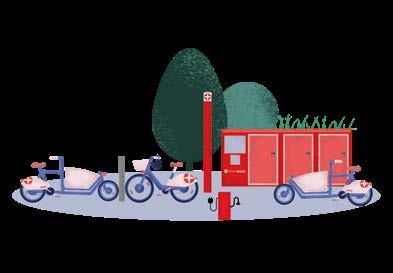
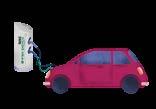
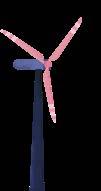

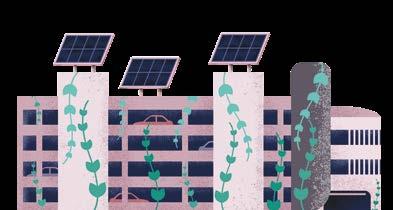
To achieve climate neutrality for Vienna by 2040, we are looking outside the box when it comes to our different areas of activity. Wiener Stadtwerke is placing particular focus on Groupwide innovation and on synergies. Doing so allows us to take advantage of all opportunities for the future.
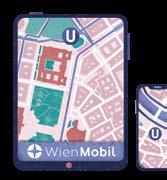
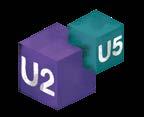
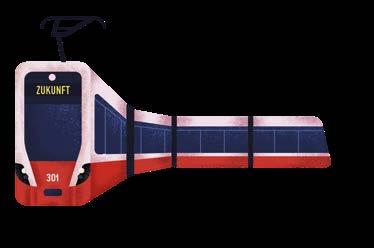

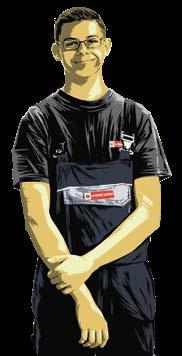
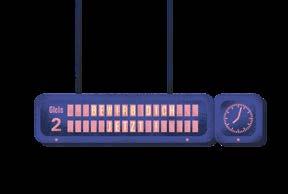
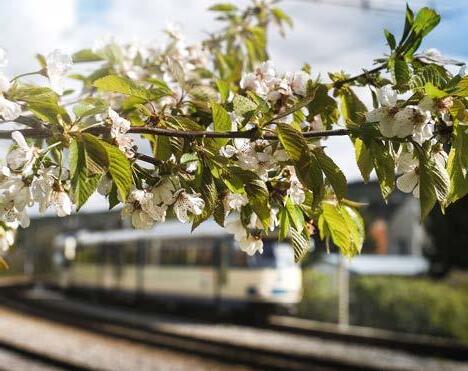
Climate change is transforming our planet. Rising sea levels, exacerbated extinction of species and extreme heatwaves threaten our livelihoods.
The warmer the Earth gets, the more severe the consequences. Science has made it abundantly clear to all of us that there is no time to lose. If we want to stop drought, flood and storms taking hold, we have to massively reduce greenhouse gases – now.
After all, the effects of man-made climate change have long since been clear to see in our everyday lives. 2022 was the year of extreme weather events. Europe experienced its hottest summer ever, forests burned, and precipitation in Austria is on the decline.
Lake Neusiedl, for example, again registered record lows in 2022.
All regions of the world are facing the challenges of the climate crisis – not just the cities. But it is the cities that face the greatest issues. Almost 60% of the world’s population currently lives in cities and are responsible for around 75% of greenhouse gas emissions. Undoubtedly, then, the success of climate protection efforts will be determined in the cities. This insight is further underpinned by the World Health Organisation’s projections. The strong influx of people is expected to continue, with almost 70% of the world’s
population expected to reside in urban settings by 2050. That is 6.4 billion people.

Those who plan, build and keep cities running are facing major challenges. More people, more traffic, more housing – it is not possible for these factors to go together without a holistic overview and an integrated approach being taken. The city of the future must be able to do several things at once. It should be designed to cope with heat, heavy rainfall, storms and drought. It should not be choked in traffic jams. It should have a good pollutant footprint. The energy supply to the city should be as sustainable as it is secure. And the phrase at the heart of it all? Climate neutrality.
So, the task is to develop environmentally sound, affordable, safe, and smart solutions for a successful climate revolution while keeping the needs and desires of people in mind. No more, no less. Generating growth while reducing CO² emissions and ensuring a high quality of life does sound like squaring the circle but we are convinced that it is feasible. We see the biggest game changers in the areas of energy and heat supply and mobility.
Almost 70% of the world’s population is expected to live in cities by 2050.
Since Vienna’s first climate protection programme was launched in 1999, CO² emissions have fallen by almost 40% per capita. In terms of district heating, the city is now one of Europe’s model metropolises, and the public transport network has been increasingly enhanced and made increasingly environmentally friendly. These are great, reassuring successes – there is no question. Yet, we can, must, and will do more. By 2040, Vienna will be climate neutral, and we at Wiener Stadtwerke are taking responsibility and making this possible.
Wiener Stadtwerke has identified key areas for action that can be used to reduce greenhouse gas emissions in our city. These include replacing fossil fuels with climate-friendly alternatives, modernising and extending our pipeline networks, and expanding climate-friendly mobility, first and foremost through Wiener Linien’s project of the century – the U2xU5 intersection.
The greatest financial and technical challenges that we will face on the road to climate neutrality are the supply of space heating and hot water. The necessary investments for decarbonising these areas by 2040 amount to some EUR 18.6bn, with thermal renovation – transforming heating
The construction sector is one of the most resource-intensive economic sectors in the world, and is responsible for almost a quarter of CO2 emissions. This is due to the frequent use of concrete. The base material for concrete is cement, and enormous amounts of CO2 are released when it is produced. Tobias Stefan, head of construction at Wiener Netze, knows this too. He studied civil engineering and then completed a master’s degree in environmental management and sustainability. A holistic ecological construction project in Ebenfurth in Lower Austria is one of various projects to benefit from his knowledge. In this project, the demolition materials from old buildings are used to create a new warehouse, with a decarbonisation process and a particularly low-CO² cement bringing added benefits. In total, this process saves up to 260 tonnes of CO². That is almost 12% of the emissions from the conventional method. The project is setting new standards in sustainable construction. Together with innovative planners, Tobias Stefan now wants to gather the experience gained into a think-tank for sustainable building.
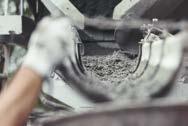
 Tunnel visit with (from left to right): Gudrun Senk, Managing Director of Wiener Linien, and Peter Hanke, City Councillor for public transport.
Tunnel visit with (from left to right): Gudrun Senk, Managing Director of Wiener Linien, and Peter Hanke, City Councillor for public transport.
systems and expanding district heating –playing a key role. That said, the extensive investments we are making are also creating opportunities for Vienna as a business location and for the city’s employment market.
We know that our greatest opportunities for reducing harmful greenhouse gases are in the areas of energy supply and mobility. However, our response to the climate crisis will only make a real difference if we intensify our efforts to consistently protect the climate in all areas. This is why Wiener Stadtwerke is pushing for collaboration and networking across all of its entities. Our Group companies look beyond their own horizons and concern themselves not with what separates them, but with what unites them. This makes us strong and has a positive influence on our work, both for the city and for our customers.
Wiener Stadtwerke sees itself as a guarantor of supply security, a key player in the climate revolution and a hub where the new Vienna is being developed and built in concrete terms. We have a clear strategy for achieving climate neutrality for Vienna by 2040.
Sustainability is also becoming increasingly important in the world of finance. Companies are being judged to an even greater extent on their approach to environmental and social issues – by their customers as well as by regulators, investors and analysts. In addition to traditional key financial figures, ESG (environmental, social, governance) information also has to be disclosed. Wiener Stadtwerke is increasing its ESG transparency by focusing on environmental factors in its reporting. What is more, we aim to increase our participation in global, industry-wide efforts to promote good ESG practices.
Our Asset Management and Treasury department responded promptly to the EU’s regulation on sustainability-related disclosures in the financial services sector. This regulation was adopted by the European Union in 2021 as part of its sustainable finance initiative. Since then, when determining our investment strategy for the WSTW funds, we have taken ESG risks into account as part of economic risks.
We put our clients at the centre of everything we do. Our mission is to ensure their satisfaction.
We secure our financial stability, because only then can we actually make significant progress towards protecting the climate and reducing CO² emissions.
We are a key partner of the City of Vienna on its way to becoming a smart city. For us, this is far more than just an idea. We are translating the Smart City concept into concrete measures.

Extreme weather events such as record-high temperatures, storms, and heavy rainfall are increasing in frequency to a drastic extent. There is no time to lose in transitioning from fossil fuels to zero-carbon and renewable energy sources. The most recent Wien Energie barometer of public opinion shows that this is not only the opinion of the experts, but also of the general population. In a representative survey of more than 1,000 Austrians, support for renewable energy projects was higher than ever before. Almost nine in ten respondents were in favour of expanding the use of photovoltaic systems. In addition to photovoltaic technology, small hydroelectric power plants and wind farms in particular have become more highly esteemed in view of the global energy crisis.
Wiener Stadtwerke also significantly expanded its use of renewable energies in 2022. The wind power and photovoltaic plants constructed in the past year generate approximately 80,000 megawatt-hours of green electricity – equivalent to the annual electricity demand of around 40,000 of Vienna’s households. With all of its renewable
electricity generation plants, Wien Energie can now produce enough green electricity for up to 700,000 households in Vienna. We want to produce a total capacity of 1,000 megawatts of green electricity by 2030.
The increased feeding in of this green electricity places new demands on the electricity grid. After all, the sun shines more at some times than at others, and the wind can be gusty or just a light breeze. Grids must be able to cope with this variance and with the increasingly decentralised feed-in, from solar panels on roofs for instance. A smart, stable electricity grid is fundamental if Vienna’s citizens are to be able to rely on a sustainable, affordable and secure energy supply in the future. Supply security is currently at 99.99%, so the bar is high. New substations, viable power connections at all voltage levels, a strengthened cable infrastructure and modern technologies –Wiener Netze is expanding at all levels, from high-voltage lines and substations through to reinforcing the cable infrastructure.
Substation: New indoor switching station ensures the supply of electricity to Vienna.
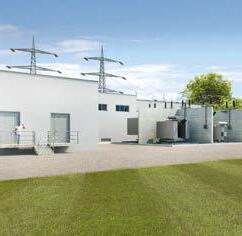
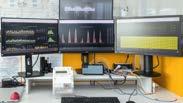

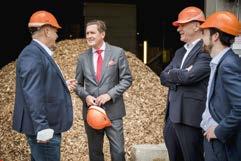

Digitalisation is making our electricity grids smarter, more efficient and more climate-friendly thanks to digital tools that can be used to dynamically control electricity generation, consumption and storage. However, this is becoming increasingly complex due to the decentralised feeding in of renewable energies as well as new and volatile methods of consumption, such as electric cars. So, in order to ensure security of supply, smart grids must be monitored closely and planned efficiently. This requires a vast amount of data, and that means measuring, measuring, measuring. Christopher Kahler, Roland Zoll and Alexander Sas, project managers for Smart Grid Monitoring at Wiener Netze, have used permanently installed sensors in transformer stations, loop boxes and disconnection boxes for the first time in field tests in order to precisely track voltage, current, active power, reactive power and power factor. These readings give them unprecedented insights into the low-voltage grid. This data is now an important component of grid planning, grid operation and grid forecasting – and a building block for the energy revolution.
 new substation will be built next to the existing substation in Simmering
new substation will be built next to the existing substation in Simmering
EUR 110m alone is going into the Simmering power plant, where a new gas-insulated switching station will be built by 2023. Work started in 2022 and the existing plant is expected to be replaced in 2025. This is a major project. Wiener Netze is investing another EUR 30m in a new substation at Alberner Hafen. These investments are also an important stimulus for the economy. Wiener Netze is also working in partnership with the energy supplier Austrian Power Grid to renovate the West substation. In contrast to the existing system, the new compact switching station is not located outdoors but is housed inside a building. This means that it is not reliant on the weather, is more compact and is more powerful than the previous infrastructure. It is scheduled to enter into operation and replace the current systems in 2025.
When it comes to the path to a climate-neutral future, progressing from the digitalisation of the electricity grid through to the establishment of a smart grid is a major task. This includes smart transformer stations that do more than just transferring electricity from one voltage level to another. In 2022, Wiener Netze upgraded the 250th transformer so that it can be measured and controlled remotely. Last but not least, smart transformers also make it possible to remedy
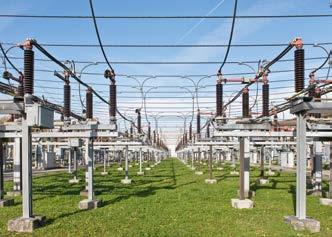
any faults in the grid more quickly. In 2022, Wiener Netze also pushed ahead with the installation of smart meters.
We have now installed 800,000 smart meters, meaning that around half of all households in the area of supply are equipped with electronic electricity meters. These meters help save electricity and benefit the environment, and they also enable new services, such as the integration of smart home systems.
In 2022, Wien Energie built solar power plants with a capacity of around 26 megawatts, meaning that we now operate more than 370 photovoltaic systems generating a total output of 111 megawatts. We have exceeded the 100 megawatt mark with our installed photovoltaic capacity, making us the premier operator of these systems in Austria. We are further expanding our position as the country’s largest producer of solar-generated power. Around 80% of the systems are located on roofs to save space. And there are many other innovative ways of making
 With the switch to renewable energies, the electricity grid must also grow.
With the switch to renewable energies, the electricity grid must also grow.
800,000 smart meters have now been installed.
the sun work for our purposes, including by involving Viennese citizens in climate-friendly energy production and encouraging them to take part – we are continuing to drive forward the area of solar power stations for citizens. One of these power stations was built at Vienna’s Central Cemetery in 2022. Wipark also knuckled down with the installation of photovoltaics on and around its multi-storey car parks. The façade of the multi-storey car park at Westbahnhof, for example, was fitted with a photovoltaic system.
WienIT also uses photovoltaics and has had the façade and roof of the Simmering data centre fitted with photovoltaic panels. The work, which also includes laying the connection lines and installing switching and metering equipment, is carried out by Wien Energie. Photovoltaics that are integrated into the façade are relatively new territory for the company. The project therefore also serves as a means of generating knowledge about the impact of these systems and allows us to scale follow-up projects or possible new business models. For WienIT, the focus is on energy efficiency and the switch to renewable energies. The system will enable WienIT to save more than 16 tonnes of CO2 emissions per year, and the company can use 100% of the solar-power electricity it generates.
In addition to roof and façade systems, environmentally friendly solar power plants are also being built in fields and other open spaces. Wien Energie is also testing innovative concepts, such as the dual use of land for photovoltaics and agriculture. In 2023, the expansion will progress rapidly on the whole – around 50 projects with a capacity of over 30 megawatts are in the planning stage.
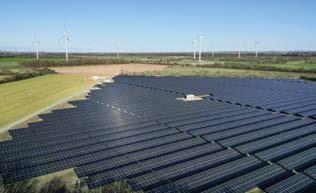
We connect the wind and the sun
Wiener Stadtwerke also pushed ahead with the expansion of wind power in 2022 and now has more than 200 megawatts in in-
stalled wind power capacity. Wien Energie now operates 92 wind turbines across 18 wind farms, with a total capacity of 217 mega-watts. Overall, Wien Energie has more than tripled its wind power output in the past ten years. And three more wind farms are to follow in the coming years, including one project in Lower Austria and two in Styria.
In the Lower Austrian municipality of Trumau, we have brought a special kind of green electricity project into being. Austria’s largest green hybrid power plant was commissioned there at the end of 2022. It is a hybrid power plant because the green
Closely interlinked: Wind and solar power in Trumau.Wien Energie has more than tripled its wind power output in the past ten years.
electricity is generated from both wind and solar energy. Combined green power generation is particularly efficient and protects the electricity grid because wind peaks and solar peaks rarely occur at the same time. The control systems of the installations are coordinated to ensure that the electricity is fed into a common power line in an optimal manner. So that the large quantities of green electricity can be distributed, Wiener Netze has also expanded the capacities of the substation in Moosbrunn in such a way that additional photovoltaic systems can be connected.
The eight wind turbines in Trumau have a total output of 27.6 megawatts, and they save 30,000 tonnes of CO² per year. The photovoltaic station next to the turbines is one of the largest in Austria, with an output of 9.7 megawatts, and generates around 10 million kilowatt-hours of green electricity per year, saving 6,000 tonnes of CO². In total, this large-scale, EUR 46m project can generate green electricity for 17,400 households across Lower Austria.
All systems are go for hydroelectric power
When it comes to achieving climate targets, Wiener Stadtwerke also relies on green electricity from hydropower. Autumn 2022 saw the successful expansion of the Töging am Inn hydroelectric plant, in which Wien Energie holds a 13% stake. This share corresponds to around 18 gigawatt-hours of additional hydropower generation, which is equivalent to the annual electricity demand of around 9,000 Viennese households. Wien Energie is also continuously developing its existing power plants and last year put a new fish ladder into operation at the Unzmarkt hydroelectric plant. In 2023, the Hoheneich hydropower plant will also receive a fish ladder. This will mean that all of Wien Energie’s power plants will have installations that enable fish to migrate along the weir structures. Wien Energie currently operates 24 hydroelectric plants in Austria and around 50 hydroelectric plants in neighbouring countries.
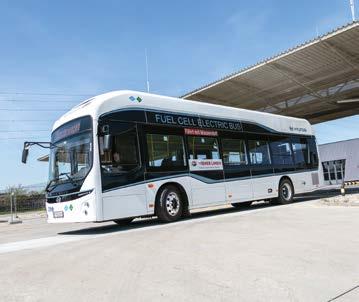
1,300 kg will be produced by the hydrogen production plant per day from summer 2023.All from a single source: Wiener Wasserstoff.
Up to
Wiener Stadtwerke is also pushing ahead with the use of green hydrogen, which is considered to be the energy source of the future. The Group has presented a clear roadmap for Vienna to become the central hydrogen hub in eastern Austria by 2030. With Wien Energie, Wiener Netze and Wiener Linien, the Group can map the entire value chain, from production to distribution and storage right through to the use of the hydrogen.
In terms of production, a milestone was reached in November 2022 when Wiener Stadtwerke started the construction of the first municipal hydrogen production plant, which, from summer 2023, will produce up to 1,300 kilograms of green hydrogen per day from green electricity. The plant is being built at the Wiener Netze Campus in Simmering and will be the first of its kind and scale to produce green hydrogen from green electricity in Vienna itself. In the electrolysis process, water is broken down into its components: oxygen and hydrogen. The released oxygen escapes into the air. The hydrogen is compressed right there and then.
Compressing the hydrogen means that it can be easily stored and transported and in a space-saving way. The daily volume of hydrogen produced is enough to fuel around 60 buses and lorries.
In addition to the hydrogen production plant, in which EUR 10m is being invested, another hydrogen filling station for buses and lorries is being built in Simmering. In future, transport and logistics companies will be able to refuel there with green hydrogen at 350 bar or 700 bar. What is more, industrial partners will also be able to obtain green hydrogen. A dedicated area will be set up for collection with tankers. It goes to show that hydrogen offers a lot of potential not only for the mobility sector, but also for industry and the energy sector – wherever fossil-based gases in industrial processes are difficult to replace with other technologies.

In Simmering, Wiener Netze has begun construction of a recycling centre, marking a EUR 6.8m investment in sustainability. The grid operator generates more than 2,000 tonnes of commercial waste in the course of a year. Almost 85% of this is recycled, and some materials such as iron or steel waste can also be sold. The new centre, which is scheduled for completion in autumn 2023, will replace two smaller recycling centres on the site. One of the main benefits of the new centre is that it will make manual post-treatment, which always occurs in the sorting area, more efficient. An electric forklift truck creates a pleasant working environment for the employees and helps to keep CO2 emissions down. Waste prevention measures, recycling and repairing operating equipment, such as transformers, all contribute towards environmental protection. All in all, with the new recycling collection centre, Wiener Netze is taking another step towards the economical use of resources and the circular economy.
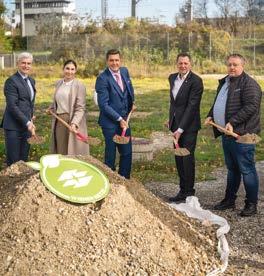
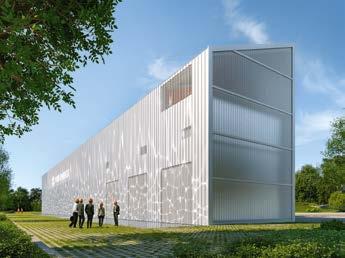
District heating is gaining importance in the transition to environmentally friendly forms of heating: 56% of the heating demand in Vienna is expected to be covered by district heating by 2040. District heating is reliable, conserves resources and avoids fine particulate production. Measuring over 1,300 kilometres in length, Vienna’s district heating network is already one of the largest in Europe, supplying heat to 440,000 Viennese households across all districts and 7,800 large customers.
Currently, a good 50% of Vienna’s district heating comes from waste heat from power plants using natural gas; the other half comes from waste incineration, waste heat from industry, and biomass. A small proportion comes from large-scale heat pumps, geothermal heat and thermal solar energy. But change is needed – and it will come. By 2040, we want to operate the district heating network entirely with energy from renewable sources.
When it comes to generating the warmth for district heating, Wiener Stadtwerke has been setting the benchmark in terms of heat pumps since 2019. At that time, the first large-scale heat pump was opened at our power plant in Simmering; with an output of 27 megawatts, it remains the largest heat pump in Austria. It uses the cooling water from the power plant systems as a heat source. The waste heat from the high-efficiency combined heat and power (CHP) plants that can no longer be used is discharged into this water. Ambient heat from the nearby Danube Canal can also be used
as a heat source. Every year, around 25,000 of Vienna’s households are securely and reliably supplied with district heating with the help of this pump, and 40,000 tonnes of CO² are saved.
Now, though, the system is getting competition – from within the company. In February 2022, Wien Energie started construction of a 55-megawatt large-scale heat pump at the site of ebswien’s sewage treatment plant in Simmering. The heat pump will be able to supply environmentally friendly heat to up to 56,000 households. It will start operating in 2023 and will be fully expanded to a capacity of 110 megawatts by 2027. Two-thirds of the energy required comes from the waste heat of the treated wastewater from the sewage treatment plant. The last third is covered by green electricity directly from the neighbouring Danube power plant Freudenau. Around EUR 70m is being invested in the project.
High-tech behind a cool façade: The Simmering largescale heat pump.Up to 56,000 households can be supplied with energy with the 55 megawatt large-scale heat pump.
A heat pump will make heating and cooling more environmentally friendly in Floridsdorf too. In future, the waste heat from the cooling system of the data centre operator Interxion, which is located there, will be used to heat the adjacent Floridsdorf Hospital. To make this a reality, Wien Energie is building a heat pump system right next to the hospital that will convert surplus heat from the server rooms into district heating for the hospital. To do this, the system extracts the thermal energy from the data centre’s cooling water, which has a temperature of around 26°C, and heats the water on the hospital side to up to 82°C. This reduces the temperature of the cooling water, which then flows back to the data centre just a few hundred metres away. Between 50% and 70% of the hospital’s heating demand is to be covered by the waste heat from the data centre. The EUR 3.5m project is scheduled for completion by autumn 2023.
In order to make district heating climate-neutral and independent of fossil fuels, Wien Energie is relying not only on large-scale heat pumps such as the one at the Simmering power plant, but also on geothermal energy as a promising source. The Aderklaaer Conglomerate contains a water-bearing rock strata several kilometres below Vienna that makes the use of deep geothermal energy a realistic proposition. Deep geothermal energy is a zero-emission, clean and safe alternative for heating buildings.
Over the past few years, in collaboration with partners from the worlds of science, research and industry, Wien Energie has thoroughly investigated this thermal water deposit and the geological conditions as part of the GeoTief Wien research project. After examining all factors, the decision was made in 2022 to “unearth” this deep treasure and build a deep geothermal plant. A site on the edge of the urban lakeside area of Aspern was identified as the optimal location for the new facility.
Through a comprehensive digitalisation project, Katharina Vizral and Kerstin Kugler from Wiener Netze, which supplies millions of people with electricity, gas, district heating and data, have taken a major step towards the circular economy. The initial plan was to document Wiener Netzte’s waste according to type, quantity, origin and location, in order to comply with legal requirements. With the help of digital tools, however, the project went a step further – the data collected is captured via an app and then automatically fed back into SAP. The data then provides answers, for example, to questions about what waste is generated in what quantities and whether this can be reduced or better separated. In the case of waste that is difficult to dispose of or where doing so is unsustainable, the perpetrators are identified and alternative products recommended. Transport logistics are also mapped so that routes can be optimised when waste is being collected. Reducing the use of materials, adapting disposal methods to meet environmental criteria, minimising transport routes and optimising the relationship between recycling and disposal means that we are taking a significant step towards the circular economy.
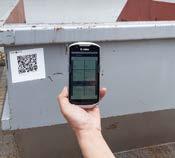
In the future, the plant in Aspern will generate climate-neutral district heating with an expected output of up to 20 megawatts and will supply up to 20,000 of Vienna’s households. To tap the thermal water, several technically demanding drilling operations will be required. Around EUR 80m is being invested in the project. Wien Energie is planning further deep geothermal plants that will supply up to 125,000 Viennese households with district heating as early as 2030. This corresponds to an annual CO² saving of 325,000 tonnes.
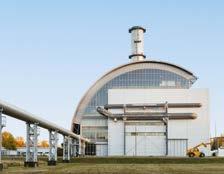
As a climate-neutral energy source, green hydrogen is highly traded, especially for the industrial, mobility and energy sectors. An operational trial at one of Austria’s most modern high-efficiency combined heat and power (CHP) plants – the Donaustadt power plant – will show what is possible in energy generation in the future. In the summer of 2022, a gas turbine there was converted to make it ready for the addition of hydrogen. The test will be the first of its kind anywhere in the world to be carried out in a commercially used gas and steam turbine plant in this power class. The aim is to gain important insights into the conversion of CHP plants to green sources. In 2023, hydrogen will initially be added at a rate of
15% by volume. In regular operation, this would save about 33,000 tonnes of CO2 every year. In the second step, the plan is to double the amount of hydrogen. If the trial is successful, the plant will be certified for continuous operation.
Networking electricity and heat generation in a smart way – that’s what power-to-heat plants are made for. Wien Energie commissioned a plant of this kind in September 2022 on the site of the Spittelau energy-from-waste (EfW) plant. The new plant converts surplus green electricity into environmentally friendly district heating. This is the case, for example, when there is a lot of wind and wind turbines produce more electricity than is needed at that moment. Therefore, the plant not only contributes to the goal of climate neutrality, but also stabilises the grid, making an important contribution to the prevention of power cuts in Vienna. Wien Energie has invested EUR 4.9m in the plant, which is already providing even more supply security and climate protection.

The energy demand in summer is not yet as high as it is in winter, but the trend is clearly moving in this direction. Heatwaves of up to 35°C are increasingly common in Vienna. These record temperatures also bring a record demand for cooling. The total daily cooling demand is highest when temperatures do not drop at night. In the hot summer we experienced in 2022, this was more often the case. But how can we stay cool through summer heatwaves in the city? The answer is with district cooling. Because anything else would further fuel global warming – it’s a vicious circle.
In district cooling, Vienna has an environmentally and climate-friendly solution, especially for densely built-up areas. The water, which is cooled to around 6°C in a central facility with highly efficient largescale machine technology, goes directly to the customers via the district cooling network and is distributed in the buildings via the in-house cooling systems. The water absorbs the heat from the building and transports it away. The water is also cooled down again centrally. This process saves around 70% of the energy cost and around 50% of the CO² emissions compared to traditional air-conditioning systems.
Wien Energie currently operates 21 cooling sites, 7 of which are centralised with a district cooling network and 14 of which are decentralised cooling solutions directly on customers’ premises, such as Vienna General Hospital or the City Hall. The number of sites is increasing by up to 15% every year. By 2030, the cooling capacity will be expanded from its current 200 megawatts to some 350 megawatts. A cooling ring is to be established around Vienna’s Ringstrasse by 2025, which will then enable all areas of the city centre to be connected to the system for environmentally friendly cooling.
A study commissioned by Wien Energie and released at the end of 2021 illustrates scenarios for the decarbonisation of Vienna’s energy system by 2040. On the basis of this study, we have defined seven fundamental action areas. These are our measures for achieving net zero emissions by 2040:
• We are expanding our renewable power generation portfolio.
• We are offering sustainable, integrated and demand-driven heating and cooling solutions: by decarbonising district heating, mainly through the development of geothermal energy and the expansion of large-scale heat pumps, and by expanding high-efficiency district cooling.
• We are identifying potential for renewable energy-from-waste (EfW) plants and opportunities to reuse captured carbon as part of the circular economy.
• We are expanding sustainable hydrogen production, including the associated fuelling station infrastructure, and we are ensuring that the technological requirements are met for using green gases in power stations.
• We are expanding the smart charging infrastructure for electromobility in the public sphere, in residential construction and for commercial customers.
• We are driving collaborative innovation and research projects to reduce emissions – with start-ups and with large companies.
• We are continuously implementing digitalisation and efficiency enhancement projects so that we can continue to ensure optimal, resource-saving use of energy.
Our internal climate protection roadmap lists detailed measures and interim targets along the path to climate neutrality.
By 2040, we aim to achieve net zero emissions.
Mobility means freedom, independence, self-determination – and a wide range of problems for humans and the environment. This is also true of Vienna. After all, 40% of our city’s greenhouse gas emissions are caused by transport. Something needs to be done. How does mobility need to be designed so that we can achieve climate protection goals and guarantee the quality of life of the people of Vienna? The answer is that many pieces of the puzzle have to fit together.
One thing is certain: swapping a petrol or diesel car for an electric one is not enough. It is true that environmentally friendly propulsion technologies are an essential stepping stone towards lower road traffic emissions. But the matter is more complex. It is about repositioning our mobility system, bringing together the different mobility concepts and their players in a functioning network that includes efficient public transport and an infrastructure that works for all road users. The more seamless the system, the more efficient and sustainable urban transport can be.
Preventing, dispersing and improving traffic – this is where we have to start. For a mobility revolution to be successful, energy consumption must be reduced, the remaining demand must be met with climate-neutral
energy and people must be able to move around in public spaces as required in a more relaxed way than before. More mobility with less traffic – that is the ideal scenario. Technological developments will help us along this path. But, above all, we have to bring the citizens with us. It will not be enough to make the future of mobility more sustainable. It also needs to be more attractive. Only then will we achieve our goal of only 20% of journeys being made by car in the future. This will not only make our city quieter and congestion-free, but it will also make a massive contribution to the climate revolution. Public transport uses ten times less energy than a car. Switching from a car to public transport saves up to 1,500 kilograms of CO2 emissions per year.
1,500 kg
CO2 emissions can be saved every year by switching from cars to public transport.
Public transport should be climate-neutral, but also safe. We want our passengers to feel at ease – whether in the underground stations, on the trains or on the night bus. This is ensured by Wiener Linien’s security department, which celebrated a small anniversary in 2022: it has been out and about around the clock for five years. Starting with 20 employees, the team has now grown to around 120 security personnel who, together with the services department, work at stations to monitor compliance with rules and the Wiener Linien transport conditions. When the Covid-19 pandemic began, ensuring that passengers complied with the obligation to wear a mask became another important task. In all situations, the focus is on de-escalation. Passengers see Wiener Linien security staff as key points of contact who are happy to help. Every year, the team provides around 30,000 people with information on timetables and directions in the public transport network.

Using public transport means protecting the climate
Comfortable, reliable, safe and fast: this is how all passengers travelling on Vienna’s underground, buses and trams should reach their destination. Somewhat incidentally, they are making a significant contribution to climate protection because public transport is environmentally friendly and sustainable. They make much better use of the available space in the city and carry more people than a car does. Public transport is a vital component for a climate-friendly future. In Vienna, for example, 2 million passengers actively protect the climate every single day.
Although the citizens of Vienna use public transport for around one-third of their journeys, Wiener Linien’s share of the city’s ecological footprint is just 1%. The reason for this is that we use our resources sparingly and carefully, operate transport services in an energy-saving manner and use innovative technologies that, for instance, make it pos-
sible for the energy that a vehicle releases through friction when braking to flow back into the grid. But above all, our trams, underground trains and some of our buses are powered by electricity, meaning that 80% of our passengers are travelling electrically and therefore climate-neutrally, because 100% of the electricity comes from renewable energy from Austria.
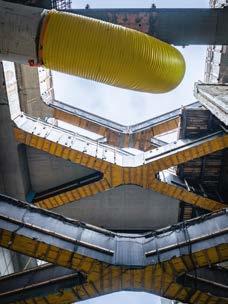
Vienna’s largest environmental project is the U2xU5 intersection, which will connect the city centre with Vienna’s outskirts in all directions. Once the eleven kilometres of track have been laid and the twelve new stations constructed, more than 300 million additional passengers per year will use the underground, trams and buses. Travel times will be shortened and the strain on the most frequently used public transport routes will be eased. Sustainable and attractive – that
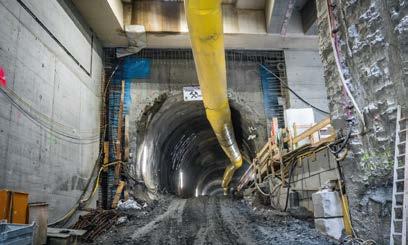
is our credo. If the passengers filling this new capacity leave their cars at home, this will save 75,000 tonnes of CO2 per year. Civil engineering work for this major project progressed rapidly in 2022. The construction progress is already clear to see. The U5 line is expected to be completed in 2026. The new U2 line from Rathaus to Matzleinsdorfer Platz will start welcoming passengers in 2028. U2xU5 will increase the performance of Vienna’s public transport network enormously. This is a good thing because efficient underground railways are the ecological lifeline of our city. Over the next few years, the City of Vienna and the federal government are investing around EUR 6bn in the project and thus in 30,000 jobs and in climate protection. Public transport also uses up less space than cars do, meaning that land can be used in more meaningful ways, such as for trees, park benches and playgrounds, allowing all of Vienna’s citizens to benefit.
With the fully automated U5 line, Wiener Linien will step into a new era of underground rail travel for Vienna in 2026. This development needs to be prepared meticulously. Therefore, a total of 144 platform screen doors and 16,000 m² of glass surfaces are being installed in the Karlsplatz, Museumsquartier, Volkstheater and Rathaus stations. The doors separate the track area from the platform so that no objects can get onto the tracks and the trains can travel uninterrupted. When the train arrives and comes to a standstill, passengers press a button to open the platform doors to board the train. The fully automated operation of public transport will bring even more comfort and reliability for passengers in the future.
Badner Bahn’s new TW500 vehicle series is also bringing more comfort to passengers. The low-floor trains are accessible and air-conditioned, offer more seats and space for prams, buggies and wheelchairs, and have modern passenger information, Wi-Fi, power sockets and USB charging facilities for smartphones, tablets and laptops. Orders have been placed for 18 of these low-floor trains. Since the end of 2022, the older highfloor models are being gradually replaced by the new trams.
Wiener Linien also invests millions in the modernisation of its tram infrastructure every year. The track construction site at Landstraßer Gürtel shows that sustainability and environmental protection come into their own during this work. A first attempt was made at this site to find out how CO2 emissions can be reduced to a minimum in terms of site planning and construction. For example, electric-powered construction machines are used and recycled concrete is used where this is technically possible. The electricity required comes entirely from renewable energy sources. The goal is to generate energy on-site in future. The project, which will be continued on a second Wiener Linien construction site, is being accompanied by the Vienna University of Technology and the Resource Management Agency (RMA).
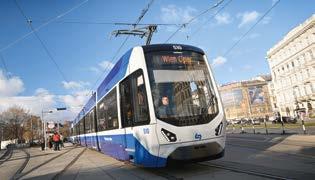
12,000 tonnes of CO2 will be saved by the buses during their first five years of operation.
We are going to step up our climate protection efforts in our 400-strong bus fleet, which is being fitted with low-emission propulsion technologies. We know that the mobility revolution is more than a propulsion technology revolution, but environmentally friendly propulsion technologies and their further development present a significant opportunity that we will not allow to pass us by. Our Euro 6 diesel buses will continue to be the foundation of urban bus transport in the future. However, the focus will be on increasingly fuelling these buses with synthetic diesel, which is not derived from fossil-based oil, so is a climate-friendly alternative to conventional diesel. By 2025,
Wiener Linien will also convert nine bus lines to electric power and one line to hydrogen power. We use both technologies as electric buses are better suited to flat areas and hydrogen buses can cope better in hillier areas. Both electricity and hydrogen will be produced from renewable energies. EUR 48m is being invested to purchase 60 electric buses and ten hydrogen buses and to construct fast-charging stations. During their first five years of operation, the buses will cover more than 13 million kilometres and save around 12,000 tonnes of CO²
Friedhöfe Wien has always placed great value on taking a conscious approach to the environment and sustainability. Wildlife and the natural world are considered an essential part of the 46 cemeteries that account for around 1.2% of Vienna’s total area. With 500 hectares of space, some 30,000 trees and 140,000 m² of natural meadows, the cemeteries are kept green and are a valuable space for relaxation and an important part of the city’s climate. Considering these figures, the effort required to keep these areas in excellent condition for visitors, including at an infrastructural level, and to keep sustainability in mind at all times is immediately apparent.
 We are converting the bus fleet to be more sustainable.
(on the right) Ultimate sustainability: The natural grave area at Vienna’s Central Cemetery sets new standards in burial culture.
We are converting the bus fleet to be more sustainable.
(on the right) Ultimate sustainability: The natural grave area at Vienna’s Central Cemetery sets new standards in burial culture.
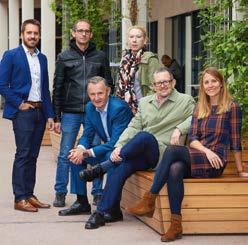
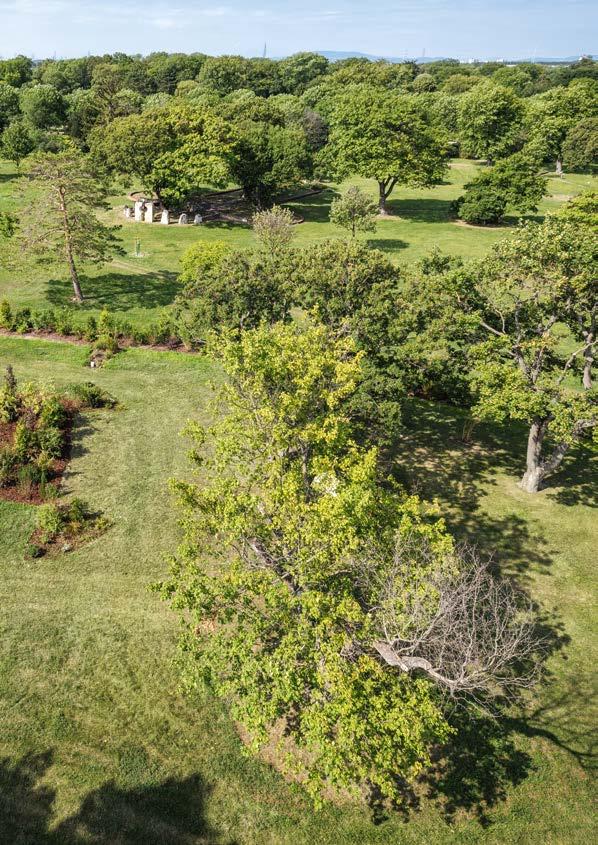
At Thomas-Klestil-Platz in Town-Town the sun burns mercilessly in the height of summer. For the employees of the Wiener Stadtwerke Group companies that are based there, the piazza is not a pleasant place for a short break. A joint project by Group Management, ImmOH! and Friedhöfe Wien has shown how the microclimatic conditions in small concrete jungles can be changed for the better. Next to the U3 staircase there is now a shaded corner planted with bamboo. Six concrete columns have been greened and fitted with new seating, creating a shady pergola. Two further “CoolSpots” with pergolas have also been installed, which offer a great setting for chilling out. Friedhöfe Wien was responsible for the planting and the greening project was coordinated by Facilitycomfort, which, together with Hauscomfort, offers technical services that focus on sustainable infrastructural services for properties. Façade greening is a special component of the company’s portfolio. The range of services offered by both companies has grown in recent years, goes far beyond traditional facility management services and focuses on sustainability. This is now made clear with a new name: Facilitycomfort and Hauscomfort have been operating under the joint brand immOH! since March 2023. The services range from the construction and management through to the use of a property.
Since February 2022, Friedhöfe Wien has been running a project with the Institute of Meteorology and Climatology at Vienna University of Natural Resources and Life Sciences (BOKU) and the Austrian Institute of Technology (AIT) that is investigating the climate relevance of cemeteries in urban areas. The results of the meteorological measurements carried out at the cemeteries at Meidling and Sievering are analysed microclimatically by BOKU. Using the results, the AIT is developing detailed simulation models from which action areas can be derived in order to further optimise the positive climate relevance of cemeteries. The models will serve as a basis for further studies and also guide the way for other cities.
Cooperation with universities has been a top priority since 2020. As part of the Biodiversity in Cemeteries project, the team led by scientist Thomas Filek is documenting the cemetery’s wildlife and plants with the participation of visitors.
Those who take the bus across the extensive grounds of Vienna’s Central Cemetery now do so in a climate-friendly way thanks to a new electric bus, which is in operation every day from 10 a.m. and visits 19 stops on the 2.5-km² grounds. Like all electric vehicles at the Central Cemetery, the new bus is powered by solar energy from the solar power plant that went into operation on the gardening premises in spring 2022. The electric bus, which replaced the previous diesel bus, was made possible in partnership with Wiener Lokalbahnen, which operates it.
Friedhöfe Wien also offers sustainable services when it comes to burial. The “Vienna natural grave” is the first cemetery site of its kind in Europe. Unlike in the past, burial in a natural grave is also possible without first being cremated. Proximity to nature is a priority throughout the site. Extensive meadow areas, shrubs, ground cover plants and a deadwood corner next to the memorial site provide shelter for insects, so form a valuable habitat.
How can car traffic at Vienna’s Central Cemetery be reduced, pollution and noise emissions lowered and visiting made more appealing? Alwin Schönach, head of infrastructure at Vienna’s Central Cemetery, has come up with a simple answer to this question: electric bikes. Electric bikes are now available for visitors to use, with the rental cost being lower than the fee for taking motor vehicles into the cemetery. The electric bikes are also equipped with baskets or trailers, so small loads such as watering cans and small gardening tools, can be transported with ease. In addition to the bikes for visitors, electrically powered cargo bikes have also been purchased for professional use, with lots of storage space for transporting equipment used in and around the cemetery.
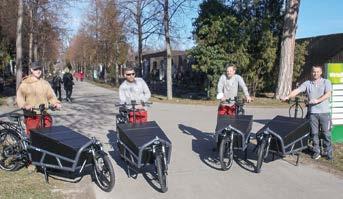
A hydrogen bus from Hyundai has been undergoing testing throughout the Vienna bus network since the beginning of 2022 as part of the long-term research project HyBus. The bus has been tested on different routes with people and with weights. Line 39A is the first to be completely converted to hydrogen buses. By 2025, ten H2 buses will be in service on this route. The green hydrogen is produced by Wien Energie, with Wiener Linien being the company’s first mobility customer for the climate-neutral fuel.
In the north of Vienna, at the Leopoldau car park, a hydrogen competence centre is being built for this purpose, at which the H2 buses will be refuelled, maintained and repaired. The goal of the HyBus research project is to launch the first three hydrogen buses on routes operated by the urban Wiener Linien, the regional Graz Linien and the alpine Zillertaler Verkehrsbetriebe and accompany this introduction with a longterm study in real operation. Among other things, the research is looking at the interconnected system and logistics for integration into a green regionally autonomous hydrogen economy.
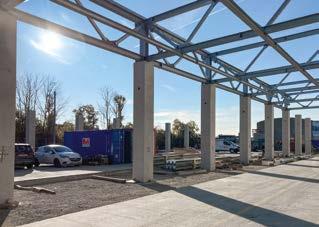
The transition to environmentally friendly propulsion technologies also requires the development of a charging and refuelling infrastructure that is adapted to the technical and operational requirements. In March 2022 we therefore began construction of a competence centre for electric mobility on the site of the former bus depot in Siebenhirten, in the south of Vienna. Wiener Linien is building a depot there for 52 electric buses and the associated infrastructure for charging, maintenance and repair. This major project places great emphasis on ecological construction, state-of-the-art ecological technology and energy efficiency. Wiener Linien is investing around EUR 40m in the construction of the competence centre, which is scheduled to be completed by the end of 2023 and will then begin regular operations.
The first construction steps of the ecologically designed e-competence centre50 electric buses will have a space in the car park of the competence centre for electric mobility.
Electromobility is a climate-friendly alternative – especially for personal transport. Electric cars are a necessary piece of the puzzle when it comes to achieving climate targets, and more and more people in Austria are convinced of this, as the enormous increase in the number of new electric vehicle registrations shows. The electric car boom can also be seen at Wien Energie’s charging stations: in 2022, the number of charges increased by two-thirds compared to the previous year. In 2022, more than 520,000 people charged up with electricity at Wien Energie’s public charging stations, compared to 310,000 in the previous year. Compared to filling up with petrol, this corresponds to a saving of 8,100 tonnes of CO²
According to surveys, a comprehensive charging network is one of the central aspects of helping electromobility achieve a complete breakthrough. This is why Wiener Stadtwerke further bolstered the charging infrastructure for electric cars in 2022. We are increasingly focusing on the expansion of fast chargers on arterial roads. By mid-2023, two fast charging parks will be built, each with ten charging points with up to 150 kilowatts per charging point. Wien Energie is installing 200 individual charging points at transport hubs and at locations with increased charging demand. The exact locations are determined on an ongoing basis in close coordination with the City of Vienna and the districts. All in all, drivers of electric cars in Vienna can already recharge using green electricity at over 2,000 publicly accessible Wien Energie charging stations. This large number of charging points makes Vienna one of the leading cities in Europe for electromobility. And before you ask: Wien Energie’s charging
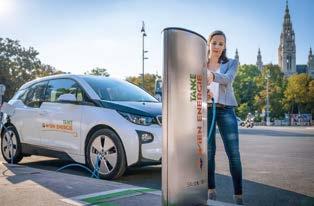
stations use nothing but green electricity to charge the vehicles that use them. Wipark also makes it easy and convenient for its customers to charge their cars. More than 20 Wipark sites have electric car charging stations; in 2023, the 500th electric charging station opened at a Wipark car park. In many cases, the cars are charged with electricity from the photovoltaic systems integrated into the façade.
The switch to electromobility will be particularly rapid for taxis and rental cars as these vehicles must be exclusively zero-emission in Austria from 2025. With the e-Taxi 2.0 project, Austria’s two largest cities, Vienna and Graz, aim to pave the way for this transition. Previous electric taxi initiatives have shown that the journeys to the charging stations and the charging times there result in uneconomical downtime. If the project consortium – which includes ten other Austrian companies and organisations in addition to Wien Energie and is coordinated by tbw research – has its way then that is exactly what will now change. In Vienna, the focus is on automated, wireless charging at the taxi rank
itself, making it possible to have plannable, economically sensible and seamless electric taxi operations in the long term. The technology used for this comes from the Austrian start-up Easelink. Charging plates will be installed at eight taxi ranks to make it possible for the electric taxis to charge wirelessly. Wien Energie is responsible for installing and operating the charging infrastructure.
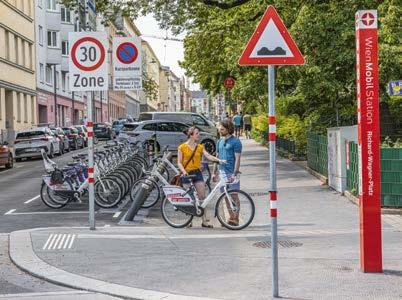
Wiener Linien is working on the climate-friendly mobility of tomorrow. Under the WienMobil brand, it is linking the dense network of buses, trams and underground trains with electric car and bike sharing in
order to offer the best service for every individual journey. In 2022, 15 new WienMobil stations were added to the existing 13, and by 2025, there should be 100 stations throughout Vienna, with different offers depending on the location. The service includes electric rental cars, rental bikes, scooter parking areas, bike storage boxes and bike service stations. In this way, Wiener Linien guarantees genuine mobile freedom, without the need for your own vehicle. So, instead of spending hours in traffic jams and searching for a parking space, you can easily use the wide range of services offered by Wiener Linien while doing something good for the climate. With the largest carpool in Vienna, we are heading towards a sustainable future together. The WienMobil app brings Wiener Linien’s comprehensive mobility range into the digital realm.
 On track for strong growth: Wiener Linien’s WienMobil stations.
On track for strong growth: Wiener Linien’s WienMobil stations.
WienMobil Rad has been in operation since 2022, with a total of 3,000 bikes available. It is the latest offering in the WienMobil family. WienMobil Rad has doubled the number of rental bikes in Vienna and has expanded the network to all districts. There are 240 WienMobil bike stations all over Vienna. In addition to setting up the stations, the company nextbike will also provide the bikes and operate them, including carrying out servicing and maintenance and organising distribution. WienMobil’s bicycles are the perfect complement to the traditional forms of public transport (underground train, tram and bus) and the other sharing services offered at WienMobil stations, such as electric scooters and car-sharing. It is a truly eclectic mix of mobility options that positions the city well for the mobility of the future and the subsequent expansion of the public transport network.
There is a mindset that cars and public transport don’t go together. But this does not have to be the case, as Wiener Linien has been demonstrating with its expanded electric car sharing service since September 2022. A pilot project with 28 rental vehicles started in 2020. In autumn 2022, the fleet was increased to 50 electric cars with the new operator sharetoo Carsharing. This number is now being increased throughout the city, with a total of 100 electric cars at 100 different locations on Vienna’s roads in April 2023. Since September 2022, 50 electric cars have been available for round-the-clock rental. The aim is to offer access to all forms of mobility in the immediate vicinity of our citizens’ homes.
Creating fun incentives for climate-friendly mobility behaviour – this is exactly what the GreenToken! app does. The app was programmed by Gernot Reiter, Nicolas Kratochwill and Viktor Vidovic from Upstream Mobility. For the three climate pioneers, it is rather straightforward: “We don’t have a plan(et) B, so we have to take things into our own hands.” The app rewards climate-friendly travel, such as walking, cycling or using public transport. A database developed by the Austrian Institute of Technology (AIT) works in the background to recognise how users are getting about, whether on foot, on the underground or by car. The app calculates the CO² consumption and automatically compares it with the value for travelling the same distance by car. If you save CO², you get points, which the app calls tokens and can be used to unlock rewards such as discounts or other treats. The more you use the app – and use public transport, cycle or even walk – the more tokens you get for your CO² savings. “By doing this, we, as a team, aim to actively contribute to climate protection for all of us within the Group and for our customers,” explain the climate pioneers.

In the past year, Vienna’s citizens ordered 113 million parcels. The scale of these purchases means that innovative projects are needed to reduce the resulting delivery traffic and congestion in the city. Would it be possible, for instance, for public transport passengers to take parcels with them on the tram on their way through the city?
A 2021 feasibility study conducted by the research institute Fraunhofer Austria and Wiener Linien showed that there is a great willingness among passengers to pick up other people’s parcels and take these with them on the tram. This initiative is now starting to be implemented within the framework of the follow-up project “Öffi-Packerl”
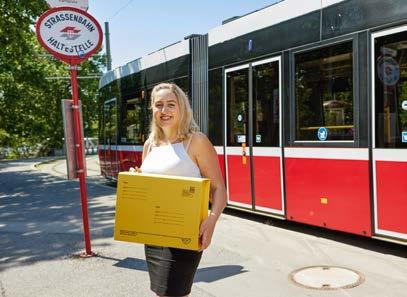
(“Public Parcel Transport”). In the first phase of the project, passenger flows are analysed to identify suitable tram routes and suitable positions for the parcel stations. An app is also being developed and parcel stations installed, which will also be powered by solar energy so won’t need an electricity connection. The first test deliveries are expected to take place from 2024.
In a pilot plant on the grounds of the Simmeringer Haide energy-from-waste (EfW) plant, Wiener Stadtwerke is looking into how waste can be used to create green fuel. The plant is part of the Waste2Value research project and was commissioned in May 2022, marking a milestone for the circular economy. It is the first plant of its kind in the world to produce synthesis gas from waste materials such as wood chippings, sewage sludge, and residues from the paper industry. This gas is further utilised directly on-site and processed into crude oil, from which CO²-neutral diesel can be produced. On an industrial scale, a plant of this kind would have the potential to produce up to 10 million litres of green fuel per year, saving up to 30,000 tonnes of fossil fuel-generated CO². In the medium term, the project is also looking at the production of green gas or green hydrogen.



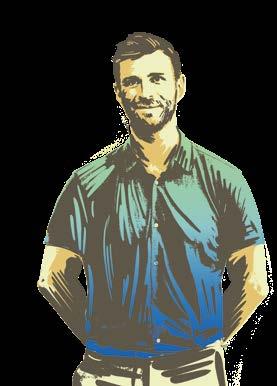
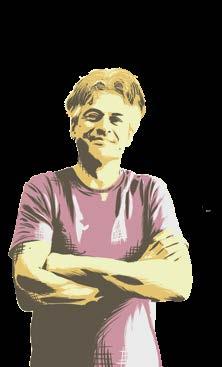
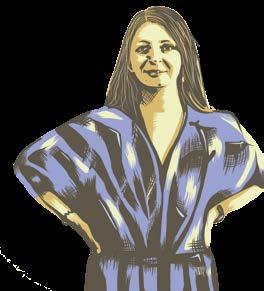
Whether at a desk, behind the steering wheel or in the research lab, thanks to their commitment and skills, our 16,000 employees are the key to achieving Vienna’s (climate) goals. The future of our city depends on them – every single day. This makes it all the more important to find adequate solutions to the shortage of skilled workers.
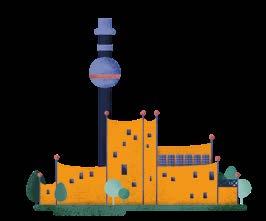
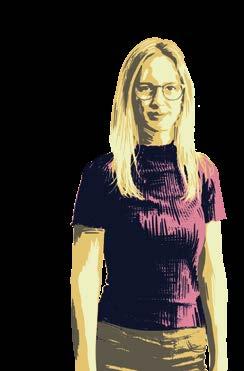
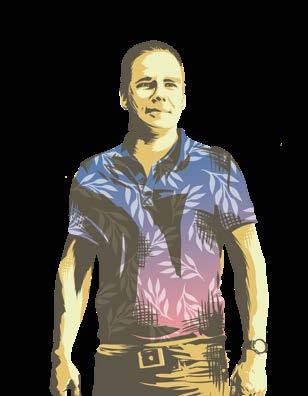
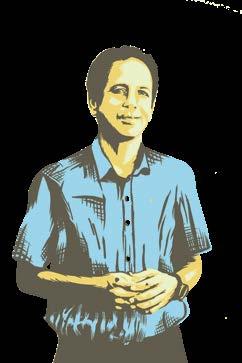

With more than EUR 7bn in revenue and some 16,000 employees, Wiener Stadtwerke is one of the largest businesses in Austria. When it comes to delivering a secure supply of electricity and heat and converting Vienna into a climate-neutral city by 2040, we, as the supplier for the city, are in the limelight.
We tackle these challenges with innovation, drive and conviction. Looking to the decisive years ahead of us, we need the greatest minds and most skilled hands in our teams. In other words, strong teams made up of pioneers who lead the way into a liveable and climate-neutral future.

Over the next ten years, 5,000 employees – or one-third of our company’s workforce – will be retiring. Recruiting qualified young talent is therefore a key area of focus at Wiener Stadtwerke. While our task is clear in this regard, the challenge we face is just as simple: for some time there have been too few skilled workers to fill open positions on the Austrian employment market. The competition between companies for the greatest talent is enormous.
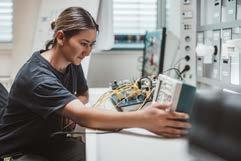
Just as before, the key criteria when choosing an employer remain job security, an attractive salary, a pleasant working atmosphere and good career opportunities. There is no doubt about it: Wiener Stadtwerke certainly performs well in these areas. Yet, today’s young talents place additional demands on their jobs that were previously less prominent, such as sustainability performance, credibility and a good work-life balance. Many graduates want to make an active contribution to climate protection in their daily work, and they strive for jobs that are green. We have good news: we can offer exactly that. We have exciting, diverse and
meaningful jobs – after all, we keep Vienna running and are turning the climate revolution into a reality. Those who work with us have a ticket to the future. Both in terms of their own development and helping to shape Vienna’s future.
Addressing the challenges of today and tomorrow cannot be done with 20th-century tools and approaches. Wiener Stadtwerke relies on digital tools, working methods and processes. And the benefits of these are numerous: they allow us to work more flexibly, in a networked way and remotely, save time, and be more dynamic and productive than ever before.
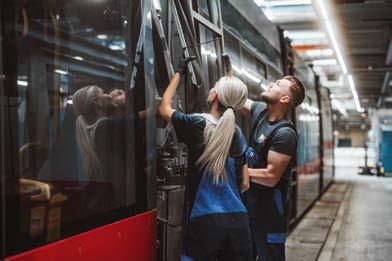
5,000 employees will retire from our company over the next ten years.
Getting young people excited about Wiener Stadtwerke, training the skilled workers of the future, retaining employees in the long term as an attractive employer – our HR experts develop innovative ideas and concrete programmes to achieve precisely these goals. It is important to look to the future, recognise trends at an early stage and act accordingly. We are well positioned to do this. Even today, our strategic staffing plans look years into the future and focus on developing an interdisciplinary team – what jobs will be needed in years to come that don’t even exist yet? What expertise, technologies and skillsets will be needed? We want to know the answers to these questions as soon as we can. For this reason, we are collaborating more and more closely with a whole host of education establishments. Doing so gives us access to an attractive graduate market of the future today.
We are meeting the challenges presented by the employment market with a strategic mix of recruiting, staff development and employer branding. This mix is reflected in our organisation: our HR experts are responsible for exactly these three closely interconnected areas, and their duties include developing policies and concrete steps for
increasing our attractiveness as an employer. They implement Group-wide staff marketing measures and take care of filling management and expert positions with appropriate candidates. They are also responsible for optimising our Group recruitment tools and for developing Group-wide staff development measures. These include overseeing overarching programmes for experienced and junior managers, developing skills in process and project management or the use of agile methods, for example, and teaching new skills in order to incorporate aspects of collaboration and new ways of working. The three areas are anchored within the Group companies, acting as a Group-wide hub for knowledge exchange and trend
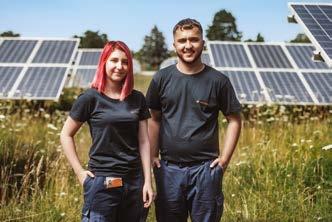
monitoring. Overarching societal trends, such as the lack of skilled workers, the still low number of women in technical careers, a looming wave of retirements due to an ageing demographic and the challenges of climate change, will continue to have a considerable impact on the HR activities of the entire Wiener Stadtwerke Group in the coming years. We have defined areas of action that are highly relevant to the entire Group and are adopted by the Group companies under individual consideration. This ensures that everyone is working towards the same goal while also enacting their own measures that are adapted to their specific challenges. This connected approach and successful cooperation of our Group companies are at the core of our HR strategy.
Our employer branding campaign “Together we will make the climate revolution a reality” portrays the Wiener Stadtwerke Group as a driving force behind the climate revolution and will draw in climate pioneers who want to make an active contribution to the future with us. In addition, our newly launched job ambassador programme is proving to be a success. The programme is a channel and a project upon which we rely for finding talent. After all, traditional job advertisements are no longer enough. We asked ourselves who knows best what it is like to work at Wiener Stadtwerke and who can give the most credible account of this. The answer is simple: the people who work at our company. Some of these are now our job ambassadors, who primarily use digital means to
let prospective employees know about their work, their teams, their exciting projects and their successes. From experience, we know that when employees personally recommend their employer, this sends a positive message, and it is frequently the case that those seeing these recommendations are more engaged. This programme helps us to address the shortage of skilled workers, especially in the IT sector. We are working together with internal IT specialists to develop formats for better targeting this sought-after group specifically.
When it comes to recruitment – especially in technical areas – we are also investing in partnerships with scientific institutions and institutes. One of the Wiener Stadtwerke Group’s most important strategic partners is the Vienna University of Technology. Our collaborative projects with the university are particularly promising as they also enable us to address young women from the technical sector in a targeted manner.
We are looking for the best hands and minds to make Vienna an even better place to live.
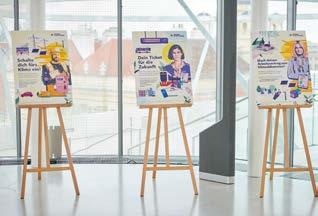
We want to forge ahead and continue to develop all aspects surrounding the quality of life in our city. To do this, we need people who will contribute, whether as an expert, a pioneer or a passionate, service-oriented team-player. And in order to find these people and keep our existing employees with us, we are strengthening our employer brand. Everyone should know that those who do their part by working with us will not just benefit from an exciting job – they will be making meaningful and effective contributions to finding solutions for our responsibilities for the future. Those who join us can apply their talents to help us make our mission a success.
How does word get around that climate protection within the Wiener Stadtwerke Group is not the responsibility of a few people working on lighthouse projects? It’s simple: you give everyone who contributes to climate change through their efforts and actions a forum to showcase their work. This is why, in 2022, we organised the Climate Pioneers Contest, which left its eclectic and far-reaching mark on the entire city, making everyone aware of Wiener Stadtwerke.
We launched our Climate Pioneers Contest at the start of April 2022: all employees within our Group were called upon to nominate themselves or colleagues and teams who are particularly committed to environmental protection in their professions. Then, in May 2022, members of an expert jury voted for their top candidates in an online ballot. There
were then two decisive votes for the shortlisted candidates, with Wiener Stadtwerke Group employees and readers of the daily newspaper HEUTE choosing their favourites. Since we also wanted to involve the people of Vienna in the decision, the contest was held in cooperation with HEUTE as our media partner.
The winners of the Climate Pioneers Contest were chosen and, since autumn 2022, can be seen on large-format street art murals around the city. They have also become part of our employer branding campaign.
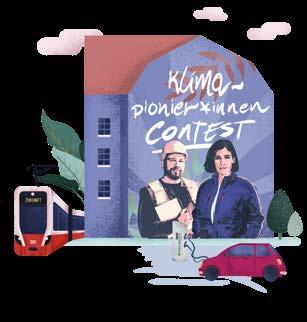

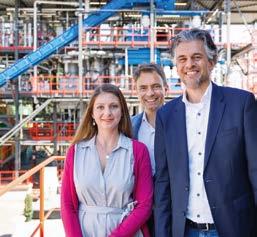
How can we create a future in which not only our own children but also all other people of Vienna and Austria can continue to live as they do now? Teresa Schubert, Martin Höller and Philipp Krobath from Wien Energie have been grappling with this issue for some time. The three colleagues work in the Research and Energy Technology department, where they help shape the future of energy supply in urban environments. As researchers, they have dedicated many years of their lives to their work in promoting the necessary transition towards climate-friendly technologies. As part of the Waste2Value research project, they focus on developing an experimental plant that produces green fuels and gases from biogenic waste material and other waste. For example, green jet fuel could be used in air traffic or green methane could be fed directly into the natural gas grid. However, it is also conceivable to add non-renewable waste materials, such as non-recyclable plastic waste, and use these again to produce plastics. A closed material cycle that makes our economy more sustainable and the future more liveable.
Philipp Krobath
Teresa Schubert Martin HöllerPeter Peternell’s enthusiasm for “his” bees is almost palpable. As a property manager at Wiener Linien, Peter is responsible not only for underground stations but also for many open spaces. He has converted one of these brownfield sites into a flowering meadow. From a beekeeper’s perspective, this vibrant space was an ideal location for beehives and the first ten bee colonies were soon introduced. There is no question that this is an important contribution towards biodiversity – bees pollinate 80–85% of all plants, after all. Since the introduction of the bees, local residents have enjoyed better blooms in their gardens, but it is the bees, insects and other small creatures that benefit most.
Peter Peternell has now found other sites where wants to try to introduce wild bees as well. He wants to reach the next milestone of two million bees: a Wiener Linien bee for every Viennese citizen.

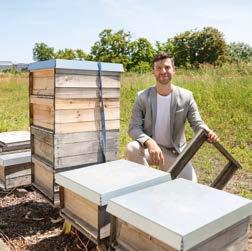 Peter Peternell
Peter Peternell


Finding new heat sources for Vienna’s district heating network and making them usable –one of the teams at Wien Energie is working on this crucial matter. Rusbeh Rezania, Helene Mooslechner and Mario Wallner are working to harness alternative regional heat resources to reduce our dependency on gas and our fossil fuel consumption. District heating can be made greener by, for example, using waste heat from cooling circuits, from wastewater or from data centres by means of heat pumps. The three colleagues are developing, planning and implementing exactly these kinds of alternative energy generation plants. One of the most exciting and promising initiatives is geothermal energy as a heat source for the district heating network. The team now knows where the necessary thermal water deposits are located below Vienna. The reservoir, which is around 3,000 metres deep and extends over several square kilometres from Donaustadt to Simmering and beyond the city limits, has a temperature of over 100°C. Geothermal potential of 120 megawatts is expected to be tapped for heating purposes as early as 2030. This will then be able to supply around 125,000 households.
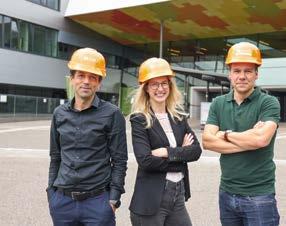 Rusbeh Rezania
Helene Mooslechner
Mario Wallner
Rusbeh Rezania
Helene Mooslechner
Mario Wallner
We specifically look to young talent who want to make an active contribution to fighting climate change. After all, we know what it means to keep the city running while also rising to the challenge of making Vienna ready to meet the environmental needs of the future. For this reason, we have developed the first Group-wide trainee programme with a focus on environmental protection and sustainability. The programme is currently the only one of its kind in Austria, Germany and Switzerland. Trainees select a specialist training stream, choosing between the alternative energies, smart infrastructure, green building, environmentally friendly mobility and digital transformation streams. This variety allows new talent to work with us in creating the climate-neutral city of the future.
In May 2022, six talents started their 18-month journey through the diverse world of the Wiener Stadtwerke Group. They will get to know the ins and outs of at least three Group companies, jumping straight in from day one as they gain deep insights into climate-relevant topics. In this way, we prepare the up-and-coming climate talents for their future with Wiener Stadtwerke and actively shaping the sustainable future of the city together with us. The trainees bring a wide variety of perspectives to their work that are based on their experience in a broad range of disciplines. So it is not only the trainees who benefit, but also Wiener Stadtwerke: the programme brings inter-company synergies to the fore, promotes the development and transfer of knowledge on the topic of sustainability and, in doing so, makes an active contribution to fighting climate change. During the programme, the trainees are supported by sustainability managers from the Wiener Stadtwerke Group, who act as mentors.
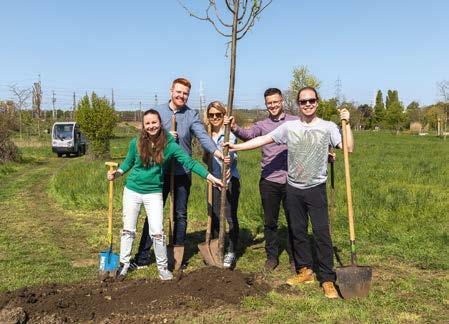
175 young talents began their training with the Wiener Stadtwerke Group in 2022.


Those who work for us are passionate about working towards something great in a great city with great people. We, in turn, strive to offer our employees the best possible working environment, with an open communication culture, strong HR development and flexible working time models. We make a concerted effort to create the ideal conditions for the professional development and growth of our employees. This is a demanding and constant, yet rewarding and meaningful task. It takes work and keeps us running. Just like we keep Vienna running.
Our employees and their skills are our most important source of potential. We are fully aware of this and we ensure that team spirit and a sense of unity are reinforced within the company. We also make sure to keep commitment and motivation at high levels. A good internal feedback culture and feedback from our customers both help to make processes better and more efficient. Innovative ideas and digital tools play an essential role in this regard.
Training centre: Courses and training are offered on a part-time basis.We offer sound
at the cutting edge of technology. Tedious routines and blinkered thinking are alien to us. Those who work for us have plenty of opportunities to change their position within the company. We promote the many strengths of our employees at an individual level and on a regular basis. That is why we also operate our own training centre, where courses and training are offered on a parttime basis. It is important to us that we take into account the challenges that each of our employees is currently facing in their respective phase of life. Whether this be a new baby, a relative who needs to be cared for, or the desire for a new working pattern: we will find the right solution. With flexible working time models, flexitime or core working hours models and the option to work remotely, to name just a few.
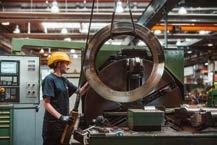
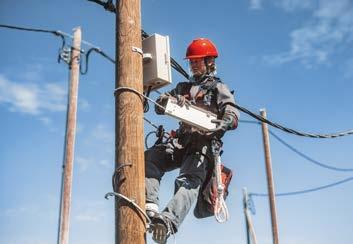
Anyone who is part of the Wiener Stadtwerke team can be sure of a trusting, respectful and appreciative environment. We offer strong values, secure and exciting jobs with meaning, benefits such as working from home, a wide range of training opportunities, and a good working environment that nurtures and encourages personal development. But we do not rest on our laurels. We know that we always have to be better.
This also means that we embrace change. Part of the DNA of the Wiener Stadtwerke Group is that we adapt quickly and flexibly to new developments, whether internal or external. This makes us strong and successful, but also entails changes to our organisation and our corporate culture that affect all Wiener Stadtwerke employees. Such changes must be embraced and communicated professionally. This is where the experts in our new Change Management and Corporate Culture department come in. They support Wiener Stadtwerke management in Group-wide projects with coaching and workshops – especially in difficult situations.
technical training
80% of the roughly 500 apprentices stay with the company after finishing their training.
The Wiener Stadtwerke Group is actively working to shape the future of Vienna, and that requires specialists. That is why we offer young people highly modern apprenticeships with great prospects and train roughly 500 apprentices, 80% of whom remain with the company after completing their training. To help counteract the shortage of skilled workers, we will gradually increase the number of apprenticeships over the years.
Wiener Linien is already laying the best-possible foundations for this: in 2022, at the main workshop in Simmering, we held the ground-breaking ceremony for a new training workshop that will offer space for 480 apprentices. At the moment, state-of-theart machine halls and workshops are being built, as are modern training, laboratory and teaching spaces. Open-plan social spaces will promote communication and the transfer of knowledge. The new Wiener Linien apprenticeship campus will be built using sustainable materials and with energy-efficient construction methods. A photovoltaic system will ensure an environmentally friendly energy supply, and the roof of the building will be greened. A geothermal heating system will be used. At the Simmering site, around 200 up-and-coming specialists are currently
For us, counteracting the climate crisis is a task for the whole of society. Wiener Netze started the “Environment Weeks” programme to raise awareness of environmental and climate issues among the apprentices. Under the motto “Out of the classroom”, the young people deal with various environmental topics by going on excursions, watching films, attending talks and taking part in workshops on subjects like waste incineration in Spittelau, wastewater treatment, compost production and the recycling of mobile phones. The Environment Weeks have been so successful that they are now offered to all apprentices at Wiener Netze.
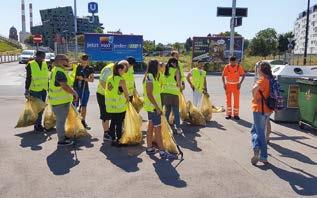
being trained in promising fields. In recent years, the proportion of women in technical training has steadily increased, accounting for around 30% of the new intake in 2022.
The Wiener Stadtwerke Group is looking for 215 new apprentices to start in September 2023 – more than ever before. This is an increase of more than 20% compared to 2022. With a total of 19 apprenticeships, the variety of training opportunities has also reached a new level. We are constantly adapting our range of apprenticeships to meet current challenges. For example, apprenticeships in electrical engineering for renewable energies and cooling technologies have been added to our training selection. Most of all, we are looking for people to join us on the dual apprenticeship in electrical engineering and mechatronics and the
apprenticeships in mechanical engineering technology and electrical engineering for plant and operating technology.
Wiener Stadtwerke apprentices also have the opportunity to obtain their Matura school leavers’ certificate with us as part of their apprenticeship. Apprentices can complete up to 50% of school leavers’ certificate courses while working for us, and do so at several locations within the Wiener Stadtwerke Group. Almost 100 apprentices with the Wiener Stadtwerke Group have decided to obtain their school leavers’ certificate in addition to their apprenticeship. This further enhances the value of the apprenticeship, which in some cases still does not have the status in society that it should have.

Markus Mareda trains apprentices in metal technology at Wiener Linien – and he has his eye on the ball. He noticed that the apprentice workshop’s bins for PET bottles and drinks cans would quickly start to overflow. With this in mind, he tasked his apprentices Dennis Stepanovic, Samuel Marinkovic, Maximilian Kostrouch and Jaqueline Doubrawa with building a compactor for PET bottles and a compactor for cans as part of their training. Using photos, the apprentices drew up plans, used common compactors as a guide, optimised these and finally produced two compactors. The 40 to 50 cans and bottles that end up in the bin each week can now be reduced to just one-third of their size thanks to these compactors. And since the containers no longer have to be collected as frequently, costs and CO² are reduced too.
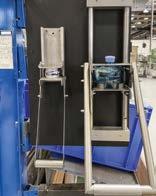
One of our greatest strengths is also one of our corporate principles: diversity. We place great importance on reflecting social realities in our workshops, offices and vehicles. We are glad that our staff members have different origins, preferences, social backgrounds and personalities. But that is not all. Wiener Stadtwerke is continuously making efforts to develop products, services, processes and structures in a way that promotes equality, is accessible and is therefore inclusive. In our Change Management and Corporate Culture department, two employees are tasked with coordinating equality, diversity and accessibility initiatives across the Group, promoting holistic understanding and creat-
ing the conditions to ensure that equality is not just a buzzword at Wiener Stadtwerke. This approach is reinforced significantly by the diversity and accessibility contacts in the Group companies.
Women are supported and developed within the Wiener Stadtwerke Group through targeted measures and suitable conditions, especially in technical fields and management functions. As a key part of its equal opportunities policies, we place a particular emphasis on helping women make their way in craft and technical occupations. By making continuous efforts, the proportion of women among our approximately 16,000 employees has been increased from 18.4% in 2018 to 21.1% in 2022. We want to spark the
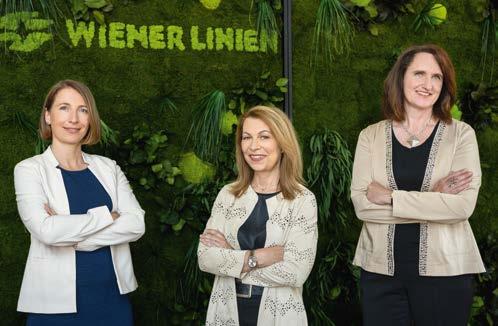
interest of young women and girls for professions that have previously been dominated by men, for example through the Girls! TECH UP Role Model Award. Our Women in Technology programme (FiT – Frauen in die Technik), which we are running in cooperation with the Vienna branch of the Austrian Public Employment Service (AMS) and the Vienna Employment Promotion Fund (waff), has been very successful so far. It gives women the opportunity to complete a two-year apprenticeship in electronics or energy technology at Wien Energie, Wiener Linien and Wiener Netze.
Wiener Linien has set a good example when it comes to women in leadership positions: since November 2022, the Management Board has been made up entirely of women. Alexandra Reinagl, Petra Hums and Gudrun Senk, three experienced managers from their own ranks, have taken the helm and are now leading one of the city’s largest employers into the future.
Helga Marksteiner swapped her profession as a nail designer for technology and is now an instructor for the twelve new FiT programme participants.
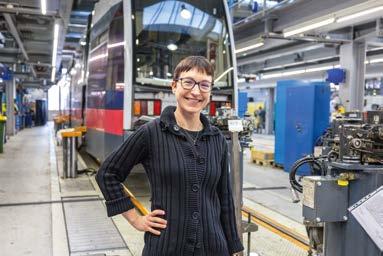
21.1% of the company’s 16,000 employees were women in 2022.
Published by:
Wiener Stadtwerke GmbH
Thomas-Klestil-Platz 13 1030 Vienna, Austria www.wienerstadtwerke.at
Design & implementation:
Berichtsmanufaktur GmbH, Hamburg
Schleusenbrücke 1, 22354 Hamburg
+49 (0)40 430 990-80 www.berichtsmanufaktur.de
Printed by: Druckwerkstatt, Vienna
Photos:
At the end of 2023, the completely redesigned Wien Museum on Karlsplatz will open its doors after four years of renovation. We were allowed to visit the construction site with our Chief Executive Officers and photographer Andreas Jakwerth ahead of the opening to take the photos for this report and get a glimpse into the future of the museum.
WSTW/Manfred Helmer: p. 3, p. 19; WE/Horak: p. 3, p. 54; WSTW/Jolly Schwarz: p. 3, p. 60, p. 61, p. 62, p. 68, p. 69, p. 70, p. 71; Andreas Jakwerth: p. 4, p. 5, p. 6, p. 7, p. 15, p. 29; Getty/Dimitri Pronchenko: p. 13; Unsplash/Jacek Dylag: p. 16, p. 33; heute/Sabine Hertel: p. 18; p. 21, p. 22, p. 66, p. 67; WLB/Zinner: p. 20, p. 32, p. 49; Wiener Netze: p. 23, p. 37, p. 43, p. 72, p. 73; Unsplash/Alex Rainer: p. 24; Christian Fürthner: p. 34; WN/Architekt Zorn: p. 36; WE/Karo-Pernegger: p. 37; WN/Tucherl: p. 38; WE/David Bohmann: p. 38, p. 41; WE/Lilly Kaltenbrunn: p. 39; WL, M.Helmer: p. 40; smartvoll/Matthias Bank: p. 42; WE/Max Kropitz: p. 44; WE/Ian Ehm: p. 44; WL/Robert Peres: p. 47; Tobias Holzer: p. 48; Harald Lachner: p. 50; WSTW/APA-Fotoservice/Schedl: p. 51; Wiener Linien: p. 53; Stephan Doleschal: p. 55; Upstream Mobility: p. 57; WL/Robert Peres: p. 57; Wiener Stadtwerke/ APA-Fotoservice_Hörmandinger: p. 63; Wien Energie: p. 65; WL/Luiza Puiu: p. 74; WL/Alexandra Gritsevskaja: p. 75 April 2023, © Wiener Stadtwerke GmbH
If you have any questions, please contact us:
Group Communications
Thomas Geiblinger +43 1 531 23-73953 thomas.geiblinger@wienerstadtwerke.at Group Press Officer
David Millmann-Stolz, B. A. +43 1 531 23-73935 david.millmann@wienerstadtwerke.at Press Officer